#post war modern architecture cologne
Explore tagged Tumblr posts
Text
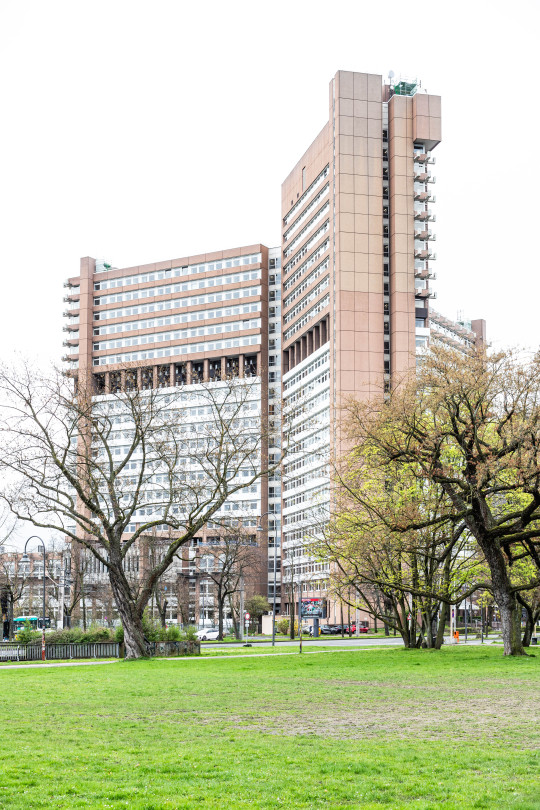
justizzentrum köln // köln sülz
architect: henrik busch
completion: 1981
the cologne justice centre, which is located directly next to the unicenter, is the second high-rise landmark in the district. in the long term it is to be demolished, but whether this will happen seems to be questionable. a refurbishment of the existing building would also be much better given the lack of building land in cologne, as this could also be used for flats.
das justizzentrum köln welches direkt neben dem unicenter liegt ist die zweite hochhauslandmarke im viertel. perspektivisch soll es abgerissen und komplett neu errichtet werden aber ob dem so sein wird scheint immer wieder fraglich zu sein. eine bestandssanierung wäre auch bei dem mangel an bauland in köln deutlich besser den dieses könnte auch für wohnungen verwendet werden. auch aus klimatechnischen aspekten wäre es sinnvoll.
#justizzentrum köln#cologne#köln sülz#sülz#henrik busch#architecture#photograpy#architecture photography#design#high rise#moderne#postmoderne#postmoderne köln#postmoderne rheinland#postmoderne deutschland#postmoderne nrw#post war modern architecture cologne#post war modern architecture germany#post war modern architecture rheinland#germany#postmoderne architektur köln#postmoderne architektur rheinland#postmoderne architektur deutschland
4 notes
·
View notes
Text
Gothitecture
gothitecture: architecture appreciated by goths. -Urban Dictionary
Gothitecture is like pornography. You know it when you see it. The Addams Family mansion, The Munsters’ house, the Psycho house, the Houses of Parliament, and Cologne Cathedral all spring quickly to mind as examples. But it’s also that dark and hyper-modern new cabin in the mountains, or that steampunk tower in that rundown industrial neighborhood, or the ruins of that 500 year old castle on the outskirts of town. Gothic, Victorian, Baroque, Romanesque, Dark Deco, Post-Modern - any and all of these can fall into this delightful architectural sub-genre so beloved by the darkly inclined.
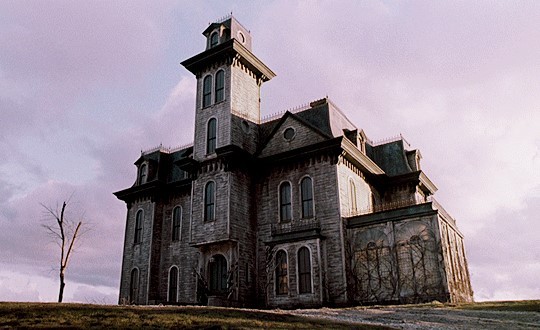
Even as a lad, my eyes would fall upon certain architectural styles and linger upon their lines and sensibilities. They seemed special. They seemed ‘right’. Passing through a neighborhood of cape cods, ranches, and split levels, my eyes would glaze over in disinterest, but as soon as that rare Victorian cottage sprang into view, my mind would jump to life - my eyes drinking up every little detail of the ornate gables, the cast iron fence, the moldings beneath the eaves. These rare beasts seemed to possess a unique quality that made them seem so special. These buildings embodied personality and grace.
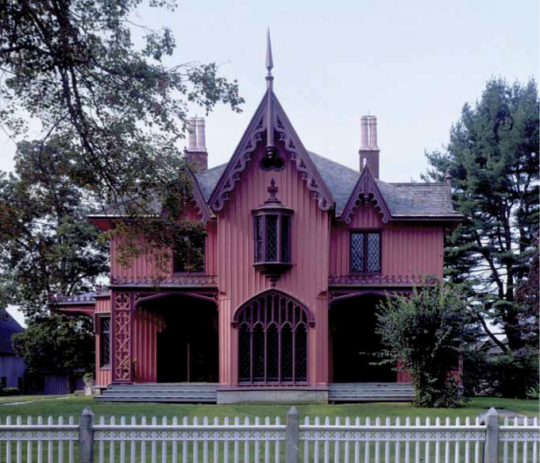
Overly introspective as most goths tend to be, I’ve often wondered as to the origins of this fascination and I may have sussed it out. When I was crazy young, 3 or 4 years of age, my mother was friendly with an old woman who lived in a very modest, yet decidedly Victorian, house. It isn’t quite large enough to be called a mansion, but it’s close. Amazingly, it still stands, although I’m sure the little old lady is long gone. Located in a severely rural area of North Carolina, it lacks the ornate finery of similar homes from even the smallest of towns, but anyone who looks upon it would agree: Victorian.

In it’s day, it was likely one of the grander residences of the county, but that day has long passed. To me, it is and always will be special because of the memories that reside within. Visiting the woman who lived there was a special occasion and my mother would make me wear nice clothes and sternly instruct me to be on my best behavior. I was to say, “Yes, ma’am,” or “No, ma’am,” and to otherwise keep my mouth shut. Not the best behaved of children, I was nevertheless happy to comply because of the wonders that hid inside. The house was filled with antique furniture and decor, most of it Victorian vintage. I can still recall being entranced by the a stereoscope viewer complete with image cards from the late 19th century. I remember the intricate crystal candy dish upon the coffee table that held horrid hard candies which might also have been of Victorian vintage. I was obliged to force one down each visit out of politeness, but it was like eating glass. It was worth it because as soon as the women set themselves to the serious business of chit-chat, I was shepherded into a separate room - the room with The Toy Box.
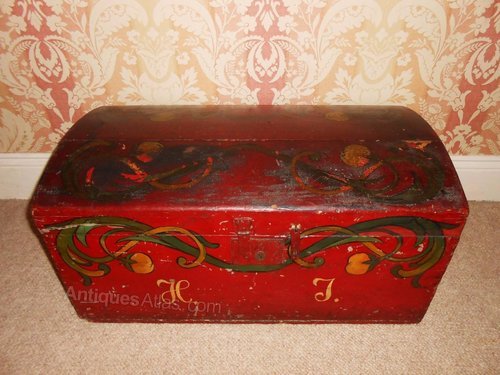
I don’t recall precisely what The Toy Box looked like, but it was large, simple, and painted. Within, were wonders untold. At least 75 years worth of toys lived inside, all in excellent condition and each eager for a child’s attention. My tiny hands fell upon tin soldiers, Jacobs Ladders, hand puppets so old their once heavy cloth was reduced to gossamer wisps, hand carved and painted tigers, horses, elephants, and spring-loaded cannons with accompanying tiny cannon balls. A battered tin Spitfire airplane spoke of the little boy form the war years who ran through the yard holding it high over head so it soared through the clouds. A faded rag-doll recalled the little Edwardian girl who used to hold her close and call her ‘My Dolly’ - it never left that little girl’s side until one day, it did. I’m sorry dolly, I don’t know where your little girl went. Perhaps she’s the old lady in the next room? I seemed to fall into that toy box for weeks at a time, although it was probably less than an hour at a go. Everything seems so much bigger when we’re young, especially time. But not all the toys were happy. There was one that scared me. It was a Jack-in-the-Box.

Allow me to clarify: it scared the hell out of me. I don’t know what it was about that thing, but I only ever cycled it once. The music the crank produced was old, sickly, and twisted. The spring rusty and diseased. It didn’t so much pop out as lurch forth. It was a nightmare in a box. I quickly shut it, latched it, and buried it beneath the other toys, but it would continue to make occasional evil sounds whenever I shifted the other toys about. I imagine it’s still there to this day, patiently waiting to terrorize another child. It’s what it does and that’s all it does. But for me, it was an evil contained. I knew it wanted to torment me, but I wouldn’t let it, so I was free to enjoy the wonders of The Toy Box. Such strong memories must carry weight, correct? Is this the reason my eyes linger lovingly on Victorian houses to this day? Perhaps. But what of gothic revival structures, or Romanesque, or Post-Modern? I never spent time inside one of those as a child with a magical toy box. Introspection can sometimes twist into a Shining Maze. Best not to stay too long - you may become frozen inside, forever.
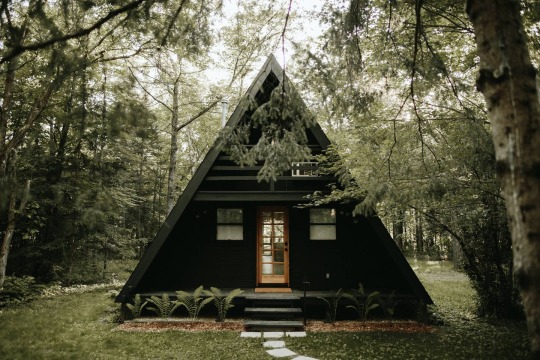
Gothitecture can also spring from a place rather than a form. Take a simple A-frame cabin in a dark wood. We goths do love a good, dark wood. Perhaps a light rain falling from an overcast sky. Ravens caw and circle above. Some forest creature runs by, unseen in the underbrush, but definitely heard - perhaps a wolf? Tendrils of fog drifting across a forest path. As night falls, broken clouds waft past the sickle moon. An owl calls out questions to the shadows beneath the trees. And late into the evening, we gather around a fire pit as the mountain cold wraps about us, and stare into the hypnotic, dancing fire. I’m so there.
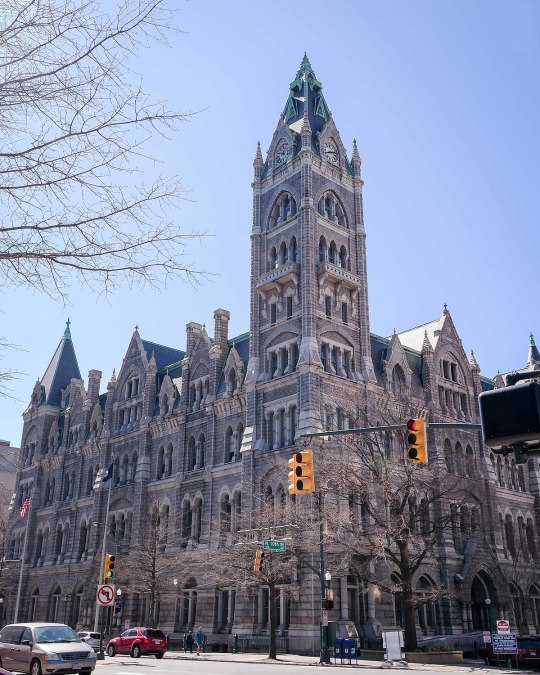
Perhaps we cast our thoughts favorably upon these styles because that’s where we belong and we full well know it. We’re meant to drift about within these halls and upon these grounds. The sounds of our heavy black boots upon stone floors is a thing meant to be. The whisper of long dark coats as they brush across walls is a sound intended. It’s a symbiotic relationship. What’s a Gothic cottage without a goth to reside within? How lonely it must be. Those gargoyles perched upon the gables are not just there to ward off evil spirits, they’re also there to welcome home long lost friends. When you look up at them, give them a friendly smile. They know their kith and kin.
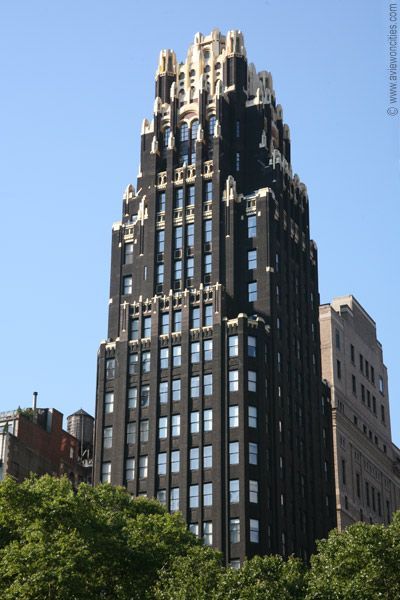
Standing before one of these dark masterworks of space and form, one cannot help but be transfixed, but play the appropriate music to accompany these edifices, and the experience becomes truly profound. Let The Sisters of Mercy, or Switchblade Symphony, or The Damned echo within these halls, and perception becomes sublime. All the pieces fall into place and all is right within our dark world. Goth music was meant to be played within gothitecture while the shadowy forms of goths dance about within. All becomes right with the world.
Perhaps then, even evil toys are lulled into slumber within the forgotten toy boxes of the Counties of Caroline.
creaturesfromelsewhere 12-29-2021
#gothitecture#goth#gothic#dark deco#romanesque#victorian#elder goth#a-frame#post-modern#baroque#musings-from-an-elder-goth#the addams family mansion#the munsters mansion#the psycho house#richmond old city hall#bryant park hotel#the sisters of mercy#switchblade symphony#creaturesfromelsewhere#darkly inclined#spitfire#jack-in-the-box#jacobs ladder#tin soldier#rag-doll#toy box#shining maze#north carolina#the counties of caroline#the damned
22 notes
·
View notes
Text
Fwd: Graduate position: CologneU.EvolutionaryGeneticsFloodplainSpecies
Begin forwarded message: > From: [email protected] > Subject: Graduate position: CologneU.EvolutionaryGeneticsFloodplainSpecies > Date: 15 February 2020 at 06:32:54 GMT > To: [email protected] > > > A PhD position is available in the research group of Prof. Juliette de > Meaux at the University of Cologne. The PhD student will investigate the > Genetics of Arabis Floodplain Species. > > The lab has recently discovered that the closely related species Arabis > nemorensis, A. sagittata and A. hirsuta are all present in floodplain > meadows along the Rhine, Danube and Elb rivers. Phenotypic studies have > shown that these species differ in various traits affecting their > ability to cope with abiotic stress and competition. For this project, > the PhD candidate will use quantitative genetics and transcriptomics > approaches to determine the genetic basis of these differences. The PhD > candidate will acquire a broad array of skills ranging from genomics to > molecular genetics and ecology, and develop a solid basis in data > management and analysis. > > The applicant must hold a Master degree in Biology (or Bioinformatics) > and prove interest in plant molecular, population or ecological > genetics. Experience in plant stress physiology or statistical analysis > of quantitative data is welcome. This position is open to applicants of > all nationalities but the usual language in the lab is English. > Applications or questions regarding the position should be sent by mail > to [email protected], with the following subject line – PhD > application Floodplain species – de Meaux lab. A letter of motivation, a > CV and the contact to at least 2 referees should be provided, all in a > single pdf file. Revision of applications will begin immediately and > continue until the position is filled. Funding is for 3-4 years starting > at earliest convenience. For more information on our lab and research > visit our website https://ift.tt/2OqstBD Interested > students currently completing their Master thesis are encouraged to > informally contact the PI because the starting date can be adjusted. > > Cologne is Germany’s vibrant Metropolis on the Rhine. The city is well > known for its wild carnival, its famous Kölsch beer, its Cathedral and > its vivid contemporary art and musical scene. Cologne is the fourth > biggest city in Germany with over a million inhabitants from all over > the world and an interesting mix of restored historic buildings and > modern post-war architecture. Most importantly, Cologne University is > one of the oldest and largest Universities in the Country. Our research > group is hosted at the Biological Center of the University of Cologne > and associated to the Excellence Research Cluster CEPLAS > (http://ceplas.eu/de/), which fosters active interactions between plant > scientists of the Universities of Cologne, Düsseldorf and the Max Planck > Institute of Plant Breeding Research. In this context, our PhD students > are assured to start their scientific career in a world-class scientific > environment. > > Juliette de Meaux > via IFTTT
1 note
·
View note
Text
Truth and simulacrum: whose timeline is it? — Maja Bogojević on Possessed
Factuality itself depends for its continued existence upon the existence of the nontotalitarian world (Hannah Arendt)
Possessed, the latest film made by Metahaven—the collective name of artists and designers Vinca Kruk and Daniel van der Velden—in collaboration with documentary filmmaker Rob Schröder, takes their radical aesthetics and progressive politics a step further from their previous film The Sprawl: Propaganda about Propaganda. Their new hybrid artwork revisits the themes of contradictions and paradoxes of multiple realities, geopolitical landscapes, new technologies, power discourse and ensuing alienation in the age of “post-truth.” Similarly to The Sprawl, this film is not easy to categorise, as it explores the notions of consumer discourse, privacy, secrecy, transparency, surveillance, veiling and unveiling, the impact of social media networks and anarchic utopianism of the internet architecture on our individual and collective lives. Through a documented collage, blending a series of drawings, photographs, animated graphics, documentary footage and fictional reconstruction, it refers to various socio-historical narratives and their processes of subordination, power and inequality, commented upon by a single but multi-fold voice-over in a non-linear narrative, which breaks and fragments in order to not only reflect the fragmentation of multi-layered realities we live in, but also to challenge them.
Possessed begins with the images of burning smart phones, war-devastated cities and landscapes, and a water spring flowing over large dark stones, overlapping with the opening narrated question:
“Would you believe?”
These first spoken words trigger a series of questions relating to the search not of the ultimate truth, but of potential truths amidst fakeness and a fixed set of beliefs regardless of the information overload diversity. The answer is, inevitably, “no”.
But the answer to the question “Would you believe in angels?” is, in the age of cynicism and hypocrisy, a surprising “yes”. This abruptly shifts the initial dystopian tone, foreshadowing the underlying final humanistic message of the film, although “there is no hope” (“what for?”) and there is no answer to the question “would you love?”, followed by the sound of a human breathing next to a smartphone. In this prologue, before the opening credits unfold, Possessed suggests in medias res that the centre of the human universe is a smartphone. The next image shows more clearly a girl lying on a bare mattressed bed, in a ruined house devoid of any furniture, with the presence of only one object—a smartphone. She greets the viewers with the words—both vocal and written—“welcome to the modern age”, followed by:
“You may think that this is a house. But there is no house. You may think that this is a girl. But there is no girl. Don’t ask me who I am.”
Examining the complex mutual relationship between the socio-political context and the work of art which documents the historic period it emerged in, the words are intercut with film negatives of houses, a helicopter, the ‘invisible’ humans (“you never noticed me, I wouldn’t be missed”), a footage of Pope Francis, all accompanied with smartphone selfies made with a raised arm in front of the masses of people and monuments.
“When I was young, I was quiet, I didn’t talk with the others, we never talk, we message… All tenderness is radical in a broken world”… “I want to know, what is a devil today? Do you want to hear the truth? Let the suffering speak. I am a breathing fragment of nothingness. Who lives or dies to care for me.”
This verbal segment is intercut with the images of the cross and a drawing of a hand collaged with the real human arm holding a smartphone, as the new disease to be cured of (by exorcism) seems to be—the reality. The raised arm holding a smartphone becomes the pervasive film symbol—it is present in Vatican, over the heads of a faceless mass, in restaurants, in shopping centres, in our empty homes, in the streets, it is everywhere—questioning the beliefs of people. Religion becomes a kind of superstition, because no matter what people ‘know’ in the information age, they still interpret the world and the reality according to their pre-existing fixed set of beliefs.
As Hannah Arendt puts it (in The origins of totalitarianism): “The true goal of totalitarian propaganda is not persuasion, but organization of the polity. ... What convinces masses are not facts, and not even invented facts, but only the consistency of the system of which they are presumably part of”.
Reconstructing artefacts of the recent and not-so-distant past, the film combines images, videos, TV, satellite/drone footage and an original narration into a seemingly incoherent and fragmented filmic reality, with many (meta)textual/discourse references, including videos of: Pope Francis in Rome, ruined Vukovar, Cologne, Aleppo, US soldiers’ flash mob dance in Afghanistan, Dubai fire and sandstorms, hurricane Katrina, migrant lines in Slovenia, queues of people in urban centres, glacier bridge collapse, statue of Liberty etc. Images of war-torn countries show demolished buildings, torn books, deserted homes with personal belongings left behind, posters hanging on the walls, newspapers, religious symbols etc.
The multiplication of simultaneously run narratives and realities and fragmentation of both the individual and the collective are reflected in the film along the axis of mainstream media/state/corporate structures vs. people/media users/consumers, conveying the notion that our agency in the information process is taking less and less responsibility. The more fake news we are served, the more the ‘truth’ becomes important: the mainstream media (and political leaders) have never been more obsessed with it, insisting in their marketing slots that they are all “telling the truth”, echoing Hannah Arendt’s visionary words: “Mass propaganda discovered that its audience was ready at all times to believe the worst, no matter how absurd, and did not particularly object to being deceived because it held every statement to be a lie anyhow.”
And:
“The danger is not actual despotic control but fragmentation—that is, a people increasingly less capable of forming a common purpose and carrying it out. Fragmentation arises when people come to see themselves more and more atomistically, otherwise put, as less and less bound to their fellow citizens in common projects and allegiances.” (The origins of totalitarianism)
But because of the new media interface, there is a new level of complex fragmentation along the axes privacy/secrecy/transparency/surveillance and control/enslavement, causing a ‘mental implosion’, in Baudrillard’s terms—“simulacrum has been brought to perfection in the 21st century thanks to media interface.” The collaged images of face recognition software, smart phone pervasiveness, the statue of Liberty, war-devastated buildings, torn books, “god land” with a Vodafone tower in the background suggest that mainstream media and dominant consumer discourses tailor their surveillance methods according to the selling/consuming axis or what they perceive as fit for their consumers’ needs. What the overload of information has brought is the illusory display of capitalist consumers’ choices (various kinds of coffee, carrot cakes, brownies, smoothies), but there are no nuances in interpretation of cultural texts, and this precisely helps to sustain the capitalist order. As corporate profit dictates consumers’ privacy, Baudrillard’s “mental involution” (a phone is melting like a brain could be melting) is bound to materialise, leading to the loss of the autonomy of the agency, the collapse of subjectivity. The imaginary enemy is ‘identified’, the crisis is created, and innocents die as a result.
“The truth?”, the narrator asks and answers: “Let the suffering speak”.
Metahaven’s concept of black transparency is reminiscent of Baudrillard’s concept of simulacrum “Simulacrum is never that which conceals the truth, but the truth conceals that it’s not there. Simulacrum is true.” One fact can arise from many models simultaneously and this anticipation and confusion between the fact and its model leaves space for all possible interpretations, even the most contradictory ones. This is how the politically anomalous - what was regarded as political aberration – can become normalcy.
Hypocrisy, carnage of profile, masked identities, faceless multitudes…
“I grew up in a city of great wealth and beauty” – these words, as it is made clear by subsequent images, allude to the baroque town of Vukovar, destroyed in the Yugoslav war - the first majorly destroyed European town in a battle since World War 2. A sign reads “18. 11. 1991 - Vukovar, sjecate se?” (“do you remember?”), with a series of images of a ghost town, with decaying, deserted streets, demolished buildings and houses, dead bodies, streams of survivors fleeing… reminiscent of today’s devastated Syria. The authenticity of such footage images evokes the importance of the responsibility of the human race in the face of war crimes and atrocities committed by humans.
Possessed, therefore, wants to remind of and challenge human indifference. The shots show rooms empty of furniture but full of books and papers from the period of the existence of Yugoslavia (which was also the leader of the non-aligned movement of the so-called third-world countries): Marxism, Kumrovecki zapisi, Danas: Jugoslavija, samoupravljanje, svijet, Class struggle and socialist revolution etc. These and images of “red” books bargains, Mao posters, Russian symbols, accompanied by the sound of a Croatian traditional song (“Spavaj spavaj diticu”, to make a clear reference to the war in Croatia), are a testimony to the recent European past, as well as a statement against general amnesia that has marked both post-industrial and post-communist societies.
But, “the war is always somewhere else”. The photo of a passport is aligned next to the photos of war tanks, weapons and military airplanes. Footage shows US soldiers rejoicing and dancing to the sampled “music” of gunshot sounds in Afghanistan.
The ‘others’ imply that their bodies are more disposable and mortal, and the pain of ‘others; seems to be peripheral to the human masses, in spite of the power of photography and media. We have face recognition software, but what and how much of human suffering do we recognize in a photo/image? We get an easy automated response to our (consumer tailored) needs (Siri, hello?), but show no reactions to others. We appear to have google maps that locate everything, but there seem to be no ‘maps for human suffering’. “As one can become habituated to horror in real life, one can become habituated to the horror of certain images,” states Susan Sontag in Regarding the pain of others.
Statements such as “we obey a fictional eye” and “our faces were attuned to a watchful eye—to adjust to being seen and shared” question and interpellate the capacity of reason and observation, even ‘common sense’ of the uniform masses, as well as the authority of god.
Indifference ‘to the pain of others’ is underscored by the repeated images of selfies and posing smilingly for selfies with a stick – a prolonged arm for the phone, restaurant images of food and drinks and a supply of a crane for “the ultimate selfie” in order to share the ultimate happiness with the world. Thus, we have cranes for photos to be shared on social media and drones for more arrogant photos and bombs. In parallel realities, innocent people die and disappear in wars, but we insist on more of our presence around the globe, offering our joy to the world.
But is this happiness fake or real? If it is real, how real is it? Do we know we are happy or do we act by orders? “Smile, be happy.” The collapse of the subject in post-modern age of neo-totalitarianism, post-truth and post-Trump?
In The origins of totalitarianism, Arendt stated decades ago: “In an ever-changing, incomprehensible world the masses had reached the point where they would, at the same time, believe everything and nothing, think that everything was possible and that nothing was true. ... Mass propaganda discovered that its audience was ready at all times to believe the worst, no matter how absurd, and did not particularly object to being deceived because it held every statement to be a lie anyhow. The totalitarian mass leaders based their propaganda on the correct psychological assumption that, under such conditions, one could make people believe the most fantastic statements one day, and trust that if the next day they were given irrefutable proof of their falsehood, they would take refuge in cynicism; instead of deserting the leaders who had lied to them, they would protest that they had known all along that the statement was a lie and would admire the leaders for their superior tactical cleverness”.
As the mutations of the image follow the shifts of historical narratives, so the collapse of the subject as well as networks seems to be imminent. A pamphlet-like verbal segment declares: “Delete your own self, the networks collapse… the screen is crushed, instagram and facebook collapse”, raising a new set of questions: have smartphones become more clever than our brains? Do we base our knowledge on networks? Will our subjectivity collapse with the collapse of networks? Will our arm break together with the stick for selfies?
“The arrogance of the camera. This helicopter won’t come to the rescue. It will patiently film my killing”.
These words echo Susan Sontag’s statement that “the shock can become familiar: the ultra-familiar, ultra-celebrated image—of an agony, of ruin—is an unavoidable feature of our camera-mediated knowledge of war”. By analogy, they also mirror Glauber Rocha’s famous words that “the camera is a lie” or Jean-Luc Godard’s that “film is a reflection of the reality or the reality of reflection?”
The irony and powerlessness of the proliferation of narratives and realities can be demonstrated further by another example (not shown in the film): the phenomenon of Ron Haviv’s photo taken during the Bosnian war in March 1992, and used by Jean-Luc Godard in his video masterpiece Je vous salue, Sarajevo (1993), which pictures the Serbian soldier Srdjan Golubovic treading over a Bosnian female victim’s head; Srdjan Golubovic later became a famous DJ Max performing in various night clubs in Serbia, until he was arrested in 2012 not as a war criminal, but for possession of drugs.
“Good citizen, happy citizen, legal citizen, undocumented person, see-through person… I travelled here from far… I tried to forget what happened to me before I fled. No one believes me. I have to be the evidence. I’m my own document”
This verbal narrative is intercut with the images of identity papers shown at borders, finger print scan check at airports, and “Ausländer” signs & grafitti, showing that, in spite of techno advances in industrial capitalism that might signal the arrival of a cyborg citizenship, the Western context, actually, reflects the return to hierarchy of white capitalist patriarchy, struggling with transculturality (which is one of the most significant influences of late post-modernity in Europe) and becoming more homogenous, closed and insecure at a time of increasing fascism and racism.
“You were quiet, you never talked”. “I” becomes “you” as an older “I” (the new generation) speaks to “you” in the future “that you never saw coming”.
“Will it be enough to love yourself?”
Contradictions and paradoxes of technology suggest that human bodies have become a source of maximum exploitation in the visual age: is it the end of the image, the end of knowledge, of imagination? Is the future foreseeable based on facebook, instagram and twitter? New forms of expression and representation are needed to reflect the changing and challenged subjectivity in the process of becoming autonomous agents of knowledge.
As the film title suggests, we are all ‘possessed’ by multiple master narratives: by technological advances, corporate structures, general amnesia, by the collapsed subject, beliefs that border on superstition, by our “shared” need to broadcast our lives to the world, selfies, fake smiles, illusory happiness (“the device did one thing really well – it made us always smile”), fake choices, fake needs created by fake consumerist capitalist discourse, by our own voyeurism and exhibitionism, by insanity and monstrosity of political leaders, powerful consumerist discourse, by our own powerlessness and indifference, failure to take responsibility, by the absence of empathy and love (“love yourself”), possessed by our own negligence to use our ‘cultural mirror’ in the midst of the collapse of the notions of self, knowledge and truth. We have timelines, but no time in the age of multiplication of signifiers and the collapse of the signifieds.
“If I had all faith, but have no love, I am nothing. Love is patient and kind, it doesn’t envy or boast, it’s not arrogant or rude… it rejoices with the truth.”
The acknowledgement of the ‘fact’ that we forgot how to love adds a new ontological dimension to Metahaven’s visual research, a more hopeful one than most current sci-fi dystopian narratives, as the present reality we live in, not the imaginary future, is already dystopian. In other words, the imaginary of the social and technological can be equally democratising and constraining, but if approached responsibly, it will rather be the former.
By analogy to Alain Badiou’s Eloge de l’amour (2009), this new neither/nor space, which is not free of imperfections, but is free of estranging social confines and prohibitions, can work as an “angel of love”, a new imaginary space for a human encounter that may never occur, but could create a new unrestrained space of love and empathy.
Such an ending, in spite of the detached, almost robotic youthful voice-over, may offer a much needed disalienating, humanistic message, simultaneously subversive and self-authenticating, as the technological and hyper-rational advancements don’t necessarily imply human progress - to paraphrase Hemingway’s words: the invention of an airplane doesn’t mean that we move faster than a horse. An alternative to this ending is the return to pre-social, pre-linguistic, pre-discursive and – pre-technological, as the final images show warehouses in ruins, desolate lands and several masked women, wearing scarves to hide faces (with emojis, stickers & comic strip captions, designed by Metahaven), whispering inarticulately with their black shadows and holding big stones instead of smartphones.
Finally, in a call to challenge the structure of subjectivity, socio-political relations and the social imaginary that supports it, Possessed transforms the current debate of the binary opposition truth/facts and lies into questions of interpretation and epistemology, contextualising them, further, to not only how something is interpreted but who it is interpreted by (are we ‘preaching’ only to the converted?), who are the agents of knowledge and how newly gained knowledge serves to justify the existing beliefs of the masses. In other words, whose timeline is it?
This is, of course, only one of possible interpretations of the multilayered filmic reality.•
Maja Bogojević (PhD) is a freelance film theorist/critic, founder and editor-in-chief of the first Montenegrin film magazine, Camera Lucida, founder and President of the Fipresci section of Montenegro, and a member of FEDEORA and UPF. She has been, until recently,_ _film theory professor and Dean of Faculty of Visual Arts at Mediteran University Podgorica, and, previously, the Dean of Faculty of Arts at the University of Donja Gorica.
28 notes
·
View notes
Text
Top 15 Interesting St. Stephen's Cathedral Facts
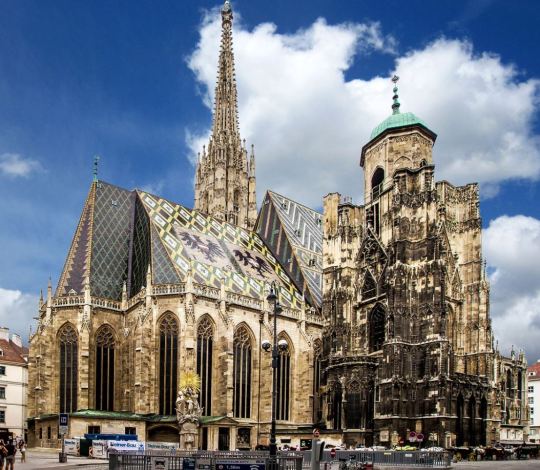
One of the most fascinating Gothic Cathedrals in the world can be found in the historical heart of the capital of Austria, Vienna. In this post, you'll discover the ultimate list of interesting facts about St. Stephen's Cathedral, an amazing church with a remarkable history commonly known as the Stephansdom.
1. The original church was built on an Ancient Roman cemetery
During the reign of Roman Emperor Augustus, in the year 15 B.C., the Romans built a fortified structure to protect a military camp that they had built on the site where the Austrian capital of Vienna is located now. They referred to the city they had founded as "Vindobona," which translates to "fair village, white settlement," and which is probably how modern-day Vienna got its name. It's only during the year 2000 that ancient graves were discovered about 2.5 meters (8.2 feet) below the surface. This means that the cathedral was built on the remains of an ancient Roman cemetery.

View of the church in Vienna / Pixabay
2. The Romanesque towers were completed in the mid-13th century
The original church on the site was built in the 12th century in the Romanesque architectural style. It was founded in the year 1137 and the initial construction phase was completed in 1147, which is the year the church was dedicated to Saint Stephen. This was an important event as it was the moment that Conrad III of Germany and his gang were getting ready to start their Second Crusade (1147-1150). The first church on the site was completed in the year 1160 and subsequently expanded between 1230 and 1245. This is when the 2 magnificent Romanesque towers we can still see today were completed. These towers stand 65 meters (213 feet) tall and are commonly referred to as the "Heidentürme," a reference to the fact that they were built on top of the Roman fortification. "Heiden" translates to "Pagans," so "Pagan Towers."
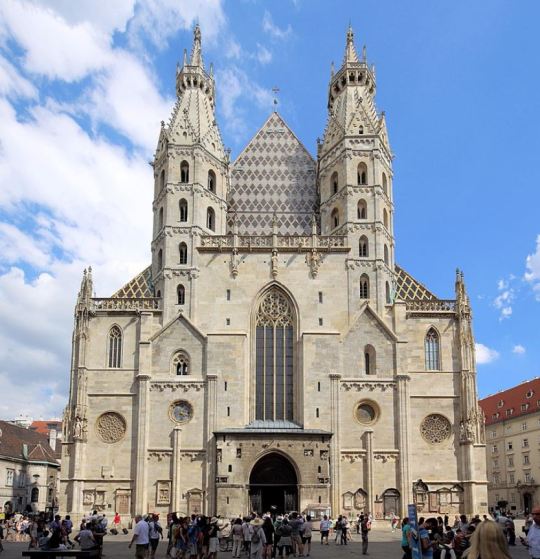
The Romanesque towers / Bwag / https://creativecommons.org/licenses/by-sa/4.0
3. The second church here dates back to the 13th century as well
Even though the two Romanesque towers were completed in 1245, the structure around them doesn't date back to this period. That's because a great fire destroyed much of the structure in 1258, except for these two towers. The towers were simply incorporated into an even bigger structure which was completed and dedicated shortly after on April 23, 1263. One of the most remarkable facts about St. Stephen's Cathedral is that this dedication in the 13th century is still commemorated every year. On this day, the big bells inside the tower ring for 3 minutes straight.
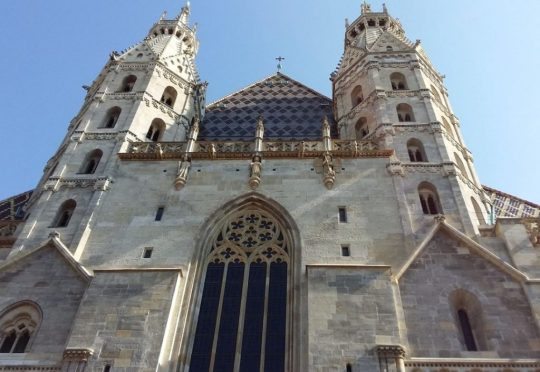
Detail of the old Romanesque part of the cathedral / Pixabay
4. The Gothic church we see today was finally completed in 1511
It didn't take long before another expansion phase was started, this time in the Gothic architectural style. In the early 14th century, King Albert I commissioned the Gothic choir which consists of 3 naves. This work was completed between 1304 and 1340 and dedicated by Albert's son, Albert II. This wasn't enough because Albert I's grandson, Rudolph IV or "Rudolph the Founder," started the construction of the westward Gothic extension of the church. The overall design of the church we see today with all its features was completed in 1511, the year that construction on the cathedral was halted altogether.
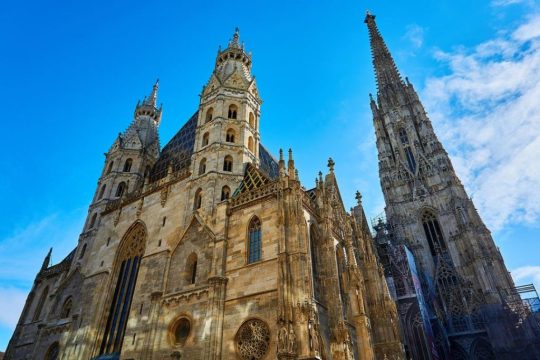
View of the Gothic additions to the cathedral / Pixabay
5. The main spire reaches the height of a modern-day skyscraper
During the final expansion phase, the church was seriously enlarged. It has a total length of 107 meters (351 feet) and a width of 70 meters (230 feet). The most prominent feature of this fascinating cathedral is the southern tower of which the spire reaches a height of 136.7 meters (448 feet). This tower was completed in 1433 and its height is the equivalent of an amazing skyscraper which turns it into the most dominant building in the area.

Drawing of the cathedral in 1847 / Wiki Commons
6. The north tower was intended to resemble its taller brother
The church could have been even more imposing if the original plan was completed. This would have turned the north tower into the twin brother of the south tower, but this plan was eventually abandoned when work seized in 1511. The construction of this tower was started in 1450 and it eventually reached a height of 68.3 meters (224 feet). Because the original plans were abandoned, this tower was topped with a Renaissance roof in the year1568, a common feature during the 16th century.
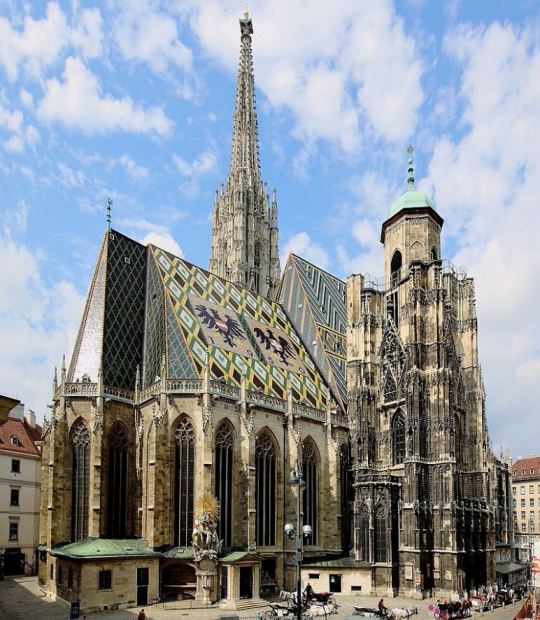
The north and south tower of the cathedral / Bwag / https://creativecommons.org/licenses/by-sa/4.0
7. The main door is probably named after a prehistoric animal
The main entrance of the church has its own name as it's referred to as the "Riesentor," or the "Giant's Door." There are a couple of theories as to why it's referred to as such, but it's assumed that it refers to the thighbone of a mammoth, a giant prehistoric animal. This thighbone was excavated during the construction in 1443 and dangled above this door for multiple decades. To both sides of this door we can find the old Romanesque towers from the 13th century.

Detail of the Riesentor / Uoaei1 / https://creativecommons.org/licenses/by-sa/3.0/deed.en
8. The most amazing feature of the church is its tiled roof
One of the most amazing facts about St. Stephen's Cathedral is that it features a magnificent roof that is covered with a grand total of 230,000 glazed tiles. This roof has a length of 111 meters (364 feet) and the south side depicts the symbol of the Austrian Empire under Habsburg rule, the double-headed eagle. The north side of the north depicts the coat of arms of both the City of Vienna and of the Republic of Austria, a remarkable sight to behold!
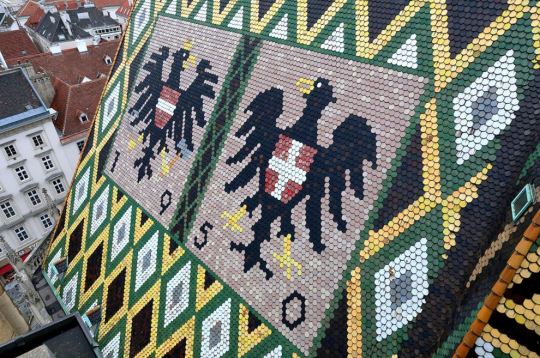
Detail of the tiled roof / Bwag / https://creativecommons.org/licenses/by-sa/4.0
9. It's home to the third-largest swinging bell in Europe
The cathedral's towers are home to a total of 23 ringing bells. The largest of them all is called the "Pummerin," or "Boomer," and is located inside the north tower. The original Pummerin was cast from 208 cannons captured from Muslim invaders during the Second Turkish Siege of Vienna in 1683. This enormous bell weighed 18,161 kilos (40,038 lbs) and it took over 15 minutes of 16 men pulling on a rope for the bell to ring. Unfortunately, this old bell was destroyed in the aftermath of World War II and replaced with the "New Pummerin" in 1951. The new bell weighs even more at 20,130 kilos (44,380 lbs), a weight that makes it the third-heaviest swinging bell in Europe. Only the Petersglocke in Cologne Cathedral (23,500 kg / 51,810 lbs) and the Maria Dolens (22,700 kilos / 50,044 lbs) in Rovereto, Italy, are heavier.
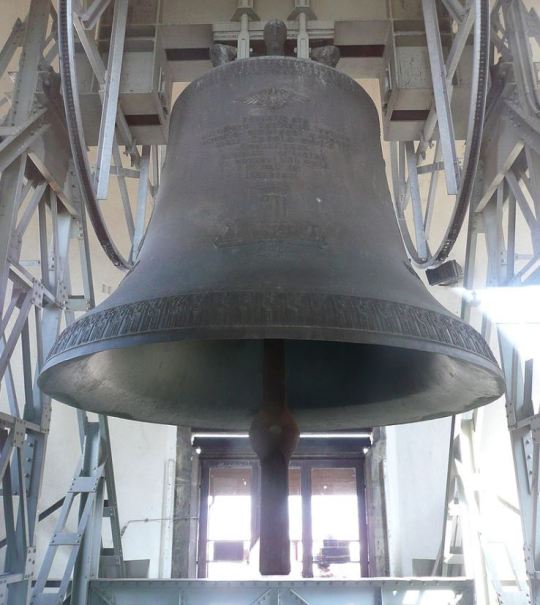
The famous Pummerin / Gryffindor / https://creativecommons.org/licenses/by-sa/3.0
10. A presumed miracle brought a Hungarian icon to the church
The interior of the cathedral is equally impressive as the exterior and multiple famous works of art can be found here. One of these is the "Pötscher Madonna," a Byzantine-style icon of St. Mary with baby Jesus that It was created in 1676 and brought to the church in the late 17th century from the church of Pócs in Hungary for a particular reason. After Holy Roman Emperor Leopold I received the word of the icon shedding tears on two different occasions, he ordered to be brought to Austria. It arrived in Vienna after a 5-month journey in 1697 but hasn't been seen shedding tears since. It can now be found in the southwest corner of the nave of the cathedral.

Pötscher Madonna / Bwag / https://creativecommons.org/licenses/by-sa/4.0
11. The 15th-century Altar underwent a costly 20-year restoration
The High Altar is the first one a visitor notices when entering the church. This Baroque altar was completed between 1641 and 1647 and represents the stoning of Saint Stephen, the martyr to whom the church was dedicated. The other famous altar in the church is the so-called Wiener Neustädter Altar, an altar that was commissioned by Emperor Frederick III in the year 1447. This altar wasn't moved to the cathedral until 1885 as it originally decorated the Cistercian Viktring Abbey near Klagenfurt (until 1776) and the Cistercian monastery of St. Bernard of Clairvaux in Wiener Neustadt. On its 100th anniversary in the church in 1985, a restoration program was started which would take 20 years to complete at a cost of 1.3 million Euro. It's only opened during weekends and opened up it depicts events in the life of the Virgin Mary. If closed, it depicts a painting involving 72 saints.

Wiener Neustädter Altar / Bwag / https://creativecommons.org/licenses/by-sa/4.0
12. A sculptor probably eternalized himself below the pulpit's chair
One of the most remarkable works of art is the stone-cut pulpit which is situated against one of the pillars of the nave of the cathedral. The sculptor is believed to be Dutch-born Nikolaus Gerhaert (1420-1473), but he didn't manage to steal the show so-to-speak. Below the pulpit, we can see the image of a man peaking through a window. This is believed to be a self-portrait of an unidentified sculptor who is referred to as the "Fenstergucker," or "Window Peaker."

Fenstergucker in St. Stephen's Cathedral / Uoaei1 / https://creativecommons.org/licenses/by-sa/3.0/deed.en
13. Some very famous people are buried inside the church
The Dutch sculptor who created the magnificent pulpit is also responsible for the creation of the tomb of Emperor Frederick III (1415-1493). This work started 25 years before his death and would take 45 years to complete. He's far from the only person who ended up being buried in the church as it's also the final resting place of Prince Eugene of Savoy (1663-1736) and 72 other members of the Habsburg Dynasty of the Austrian Empire whose remains are in the crypt.

Tomb of Emperor Frederick III / Bwag / https://creativecommons.org/licenses/by-sa/4.0
14. The south tower was completely restored in the 2000s
During the 2000s, the exterior of the church has been restored as the accumulated dirt turned most parts of the stones completely black. The most prominent feature of the church, the south tower, was restored as well. This restoration project, which mostly involved cleaning the limestone) was finally completed in the year 2008 and the south tower pretty much looks brand new again!
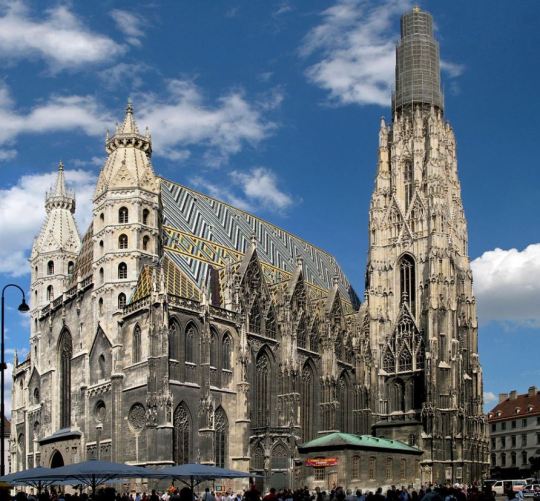
The south tower during restoration / Andrew Bossi / https://creativecommons.org/licenses/by-sa/2.5
15. The interior looks amazing after a renovation as well
One of the most fascinating facts about St. Stephen's Cathedral is that the interior looks amazing as well, especially following a similar renovation project. The cathedral features several chapels which are adorned with statues and amazing works of art. This means that entering the church is a must-do item on your Vienna bucket list!
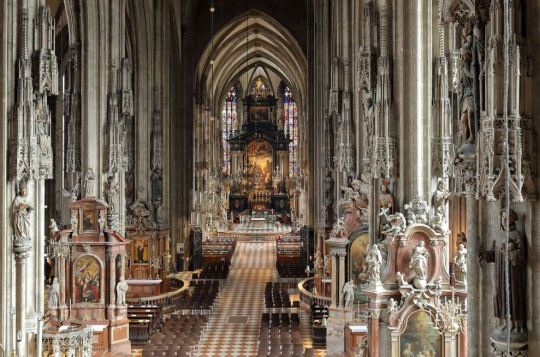
The amazing interior of the Vienna Cathedral / Bwag / https://creativecommons.org/licenses/by-sa/4.0 Read the full article
#Architecture#Churches#famouschurches#famouschurchesintheworld#FamousGothicCathedrals#LandmarksinVienna#MostfamousGothicCathedrals#StStephensCathedral#StStephensCathedralfacts#Vienna
1 note
·
View note
Text
BASTIAN Gallery, Berlin Dahlem
BASTIAN Gallery, Berlin Dahlem Building Project, German Architecture News, Images
BASTIAN Gallery, Berlin Dahlem
16 Oct 2020
BASTIAN Gallery
Architect: John Pawson
Location: Berlin, Germany
The Bastian family will establish a new gallery space in Berlin Dahlem, Taylorstraße. With construction already underway, the opening of the gallery space is scheduled for Autumn 2021.
The BASTIAN Gallery building will be located on the periphery of a park not far from Grunewald and, designed by renowned architect John Pawson, it will respect the proximity and context of the nature park by opting for the typology of a pavilion-like form.
John Pawson is considered one of the most important architects of our time. The international prestige of the British architect is built upon his uncompromising dedication to the principle of clarity. In the reduction of his designs, he strives for simplicity as perfection.
In 2019 Céline, Heiner and Aeneas Bastian donated their gallery building Am Kupfer-graben in Berlin Mitte to the Prussian Cultural Heritage Foundation to help establish a centre for cultural education next to Museum Island. An exhibition space was also opened in the heart of Mayfair in London in 2019; the gallery continues to expand and fortify its international presence.
The new Berlin gallery will continue its exhibition programme of German and American post-war modernism from next autumn. The exhibitions will be accompanied by public lectures, readings, and concerts. The events will be open to the public and free of charge.
Aeneas Bastian comments, The decision to open a new location in Berlin is a sign of confidence in a difficult time due to the consequences of the pandemic and a firm commitment to Berlin as an important place for art.
Established by Céline and Heiner Bastian in 1989, the gallery is directed by Aeneas Bastian since 2016. 20th Century artists, such as Pablo Picasso, Jean Dubuffet, as well as German and American post-war artists including Joseph Beuys, Anselm Kiefer, Cy Twombly, Robert Rauschenberg and Andy Warhol, form the core of the exhibition program.
The gallery publishes numerous exhibition catalogues, artist monographs and catalogues raisonnés. BASTIAN participates at international art fairs, such as MASTERPIECE London, Taipei Dangdai, Art Cologne and Art Düsseldorf.
From 2007 until 2019 BASTIAN Berlin has shown exhibitions dedicated to modern and contemporary art. At the beginning of 2019, the Bastian family donated their building Am Kupfergraben to the State Museums of Berlin, who have established an art education center there, which was inaugurated on 1 September 2019.
Located in Mayfair, the London gallery opened on 1 February 2019. Since its opening the gallery has presented solo exhibitions of Andy Warhol, Cy Twombly, Joseph Beuys, Dan Flavin and Hans Hofmann.
Architects: John Pawson
Image ® John Pawson Ltd, Courtesy BASTIAN.
BASTIAN Gallery, Berlin Dahlem images / information received 161020
OMA, architects
Location: Axel-Springer-Straße 65, 10888 Berlin, Germany
Architecture in Berlin
Berlin Architecture Designs – chronological list
New Media Campus for Axel Springer in Berlin Design: BIG + Bollinger+Grohmann + Man Made Land +Topotek 1 + Kardoff Ingenieure + Wenzel+Wenzel image by architects Media Campus Axel Springer Another of the three shortlisted entries for the new Media Campus for AXEL SPRINGER in Berlin, Germany.
Berlin Buildings
Berlin Architects
Berlin Architecture Walking Tours
Dutch Embassy Berlin
Jewish Museum Berlin
German Architecture
German Architects
Berlin Architecture
Comments / photos for the BASTIAN Gallery, Berlin Dahlem Architecture page welcome
Berlin
The post BASTIAN Gallery, Berlin Dahlem appeared first on e-architect.
0 notes
Text
Gothic Hotels (and Songs by R.E.M., Part 2) — The Agenda by Tablet Hotels
It’s Halloween, so we’re taking a look at hotels with Gothic architecture, a style synonymous with the mysterious and macabre. Why did we also include songs by R.E.M.? The answer may shock you.
Earlier this year, we wrote about some of our favorite Southern hotels, comparing them to songs from one of our favorite Southern bands, R.E.M. So why write about R.E.M. again? Well, the band actually saw the first story, liked it, and asked if we’d do a part two. Not since Coppola and The Godfather has anyone had such a good reason to make a sequel.
There’s hardly been a better time to talk about “scary” hotels, either. This is Halloween week, of course, and it’s also the week that R.E.M. releases the 25th Anniversary reissue of Monster, their terrifyingly titled ninth studio album. But instead of another list of haunted hotels, we’re focusing on the style of architecture most commonly associated with things that go bump in the night.
Gothic architecture secured its association with the spooky and supernatural in the 18th and 19th centuries, when writers like Horace Walpole, Edgar Allen Poe, Mary Shelley, and Bram Stoker chose Gothic castles and abbeys as the backdrop for their stories of darkness and death. An entire genre of horrifying literature became known as Gothic fiction, and an entire mode of architecture was never viewed the same again.
R.E.M. has crossed paths with the Gothic label as well — especially during the first half of their career. With a sound driven up from underneath Georgia’s genteel facade, the Athens natives were considered a sort of modern musical counterpart to the Southern Gothic literature of William Faulkner and Flannery O’Connor. Sonically and thematically, their music reflects the murky and eccentric spirit of the region, underscoring its postbellum tensions and investigating its idiosyncratic characters.
And so, without further ado, enjoy this selection of thirteen hotels with Gothic architectural elements, paired with some of R.E.M.’s most Southern Gothic songs.
Follow along with our R.E.M. — Southern Gothic playlist on Spotify or Apple Music.
The Qvest
Cologne, Germany
“Wendell Gee” — from Fables of the Reconstruction, 1985
The 19th century obsession with Gothic elements comes through loud and clear in The Qvest. Now a hotel, the 1897 building initially housed Cologne’s archives and a public library. In keeping with the reigning aesthetic in those days, a neo-Gothic influence touched just about every element in the construction: ribbed vaults, lancet windows, hood moulding, tracery, and an overarching verticality all remain visible today. Similarly, all the elements of R.E.M.’s Southern Gothic signature come through in “Wendell Gee,” one of the band’s most under-appreciated pieces of musical mastery, and the final track from their darkest and most overtly South-saturated album.
See More Photos
1898 The Post
Ghent, Belgium
“Strange Currencies” — from Monster, 1994
“Strange Currencies” might not feel at first like a song with Southern folk roots, but imagine it without Monster’s trademark distorted guitars and you begin to hear the swagger and sway of classic country-blues. It’s the kind of plaintive-yet-hopeful ballad that R.E.M. perfected throughout their career, and it’s paired on this list with 1898 The Post, a hotel that’s equally the shining example of a genre. The old Central Post Office in Ghent was completed at the turn of the last century, and while its neo-Gothic style makes it look much older than that, a brand-new renovation has this beautifully preserved structure ready to host guests in the current century and beyond.
See More Photos
Bryant Park Hotel
New York City, New York
“Carnival of Sorts (Boxcars)” — from Chronic Town, 1982
Starting with the gargoyle on the cover, R.E.M.’s debut EP Chronic Town oozes a dark, peculiar, and highly literary Southern Gothic vibe. And “Carnival of Sorts (Boxcars),” with its calliope intro and images of clandestine railway activity, all but revels in the murky mood. Gargoyles don’t make an appearance on the Bryant Park Hotel, despite its home inside the American Radiator building, a strange and imposing black-gold gothic skyscraper that towers above the midtown park like something out of a comic book — or out of Ghostbusters. Penthouse guests might be safe from that movie’s statues-turned–terror dogs, but the hotel does look down on the New York Public Library, where other ghost-busting scenes were filmed.
See More Photos
Kruisherenhotel Maastricht
Maastricht, Netherlands
“The One I Love” — from Document, 1987
“This one goes out to the one I love…” — the instantly recognizable first line from R.E.M.’s 1987 hit sets the stage for a song that practically drips with heat and humidity. This song, as much as any other, announced to the world that R.E.M. was a contemporary sonic interpretation of the steamy South found in the plays of Tennessee Williams. Kruisherenhotel Maastricht is another thoroughly modern interpretation, this time of a fifteenth-century Gothic monastery. Designer Henk Vos transformed the original monks’ cloisters into handsome hotel rooms that are anything but ascetic, and even the relatively undisturbed spaces are deeply altered by the introduction of sleek furnishings and bits and bobs by the likes of Le Corbusier, Philippe Starck and Marc Newson.
See More Photos
Conservatorium Hotel
Amsterdam, Netherlands
“Country Feedback” — from Out of Time, 1991
The Conservatorium is a radical repurposing of Amsterdam’s Sweelinck Conservatorium building — its soaring institutional spaces and ornate century-old neo-Gothic construction transformed into a contemporary design hotel. Offering a focus on pop music alongside more traditional conservatory studies like classical and jazz, there probably was a surprising bit of guitar feedback heard in the Conservatorium during its time as a music school. There’s a bit of feedback heard in “Country Feedback” as well, wandering almost incongruently in between and around more traditional country sounds like pedal steel guitar and organ, adding the right amount of frustration and edge that the song’s cryptic lyrics cry out for.
See More Photos
Ace Hotel Downtown L.A.
Los Angeles, California
“So. Central Rain” — from Reckoning, 1984
Legend has it that “South Central Rain” refers to massive downpours and flooding in R.E.M.’s home state of Georgia in 1983. The band was apparently out on tour, and wasn’t able to check in on family members because the storms had knocked out the phone lines. Specifically, the legend asserts, they were in Los Angeles, which is the reason for this hotel-song pairing, and not because of L.A.’s South Central neighborhood. For the Gothic connection, look no further than the United Artists building, a 1920s Spanish Gothic Revival tower and theater that is the current home of Ace Hotel Downtown L.A.
See More Photos
SINA Centurion Palace
Venice, Italy
“Oh My Heart” — from Collapse Into Now, 2011
Michael Stipe wrote “Oh My Heart” about post-Katrina New Orleans. His lyrics can sometimes be impenetrable, but not here. This is very clearly a song about resilience in the face of tragedy and persevering into the future so we can continue to honor the past. There are no New Orleans hotels on this list, but maybe that would’ve been too cute. Instead, we turn to another timeworn city fighting back against Mother Nature and climate change: rising sea levels have led to regular flooding in Venice, the home of Centurion Palace and its postcard-perfect Venetian-Gothic exterior. The former convent is located in one of the oldest neighborhoods in the city, which has survived everything from World Wars to the Black Death, and we’re confident it will survive its latest challenge.
See More Photos
Chicago Athletic Association
Chicago, Illinois
“Oddfellows Local 151” — from Document, 1987
Long before a recent renovation converted it into a stunning boutique hotel, the Chicago Athletic Association was a private club for the city’s (male) movers and shakers. Dating back to the final decade of the 19th century, this Venetian Gothic landmark hosted the kinds of government and business elite that “Oddfellows Local 151” suggests are at least partially responsible for the plight of the characters in the song: the homeless population that was left behind by the political and economic machines of 1980s America. Document was an album filled with fiery passion as R.E.M. found their political footing — no more so than on this, its closing track.
See More Photos
High Line Hotel
New York City, New York
“Swan Swan H” — from Life’s Rich Pageant, 1986
Chelsea’s High Line Hotel makes its home in an imposing red-brick Collegiate Gothic seminary — and its designers, the local duo Roman and Williams, managed to created an enormously fun hotel in what was an otherwise solemn environment. R.E.M. pulled the same trick, but in the opposite direction, with “Swan Swan H.” At first glance, this song about the Civil War appears to be a celebration of freedom, but as it progresses the true cost of a destructive moment in American history becomes more clear. And while the lyrics reference wooden beams of a presumably different sort, for the purposes of this list, we’ll think about the ornate ceiling of the Hoffman Hall event space, pictured above.
See More Photos
Le Chateau Frontenac
Quebec City, Canada
“World Leader Pretend” — from Green, 1988
A century-old Gothic Revival castle high on a bluff over the St. Lawrence river, Le Château Frontenac is Québec City’s most famous landmark, and has hosted some of the world’s most famous guests. Musicians, movie stars, and titans of industry have walked its halls, but powerful politicians may have left the greatest influence — suites are themed after heads of state who have stayed at the hotel. According to Michael Stipe, “World Leader Pretend” was the most political song of the band’s career up to that point, and it might continue to be so today. After clashing with Donald Trump over his unauthorized (obviously) use of “It’s the End of the World as We Know It (And I Feel Fine),” the band followed up by contributing “World Leader Pretend” to an anti-Trump compilation.
See More Photos
Chateau Marmont
Los Angeles, California
“Drive” — from Automatic for the People, 1992
The Chateau Marmont was constructed to the specifications of the Loire Chateau Amboise in France, and scattered throughout are certain reminders of the French late Gothic Flamboyant style. But though inspired by France, this particular chateau and its infamous scenes of Hollywood decadence could only exist in Los Angeles. Likewise, “Drive” is a song that could only have come from R.E.M. With an echoey atmosphere as haunted as the hallways of the Chateau, the song drives forward slowly and madly, calling out like a pirate radio station in the middle of the night, seeking to empower the youth through rock and roll.
See More Photos
St. Pancras Renaissance Hotel
London, England
“Life and How to Live It” — from Fables of the Reconstruction, 1985
In R.E.M.’s hometown of Athens, Georgia, there once lived a man named Brev Mekis. Suffering from schizophrenia, Brev split his house into two totally different apartments, each with its own unique furniture, books, clothing, even pets. To suit his disparate personalities, Brev would periodically switch back and forth between his two lives. After he passed away, discovered inside the house were hundreds of identical copies of a book he had written called: “Life and How to Live It.” The great Gothic structure at St. Pancras has a split personality of its own. On the one hand, it is a lavish, luxurious hotel. On the other, an introduction to a busy, full-functioning rail station. Taken all together, it is the ideal of a grand European railway hotel.
See More Photos
Borgo dei Conti Resort
Perugia, Italy
“Find the River” — from Automatic for the People, 1992
Borgo dei Conti Resort is a deeply romantic place. Originally built as a fortress in the 13th century, the estate was remade into a noble home some 500 years later. Surrounded by acres of gardens and lawns and parkland, the building is a dramatic example of 19th-century neo-Gothic architecture, still as imposing as ever today. On its sprawling grounds, you’re likely to find some of the herbs and fruits mentioned in “Find the River,” a song that celebrates life specifically because death is always present. Despite the heavy themes, “Find the River” is a gorgeous and uplifting song. It closes out an album full of radio hits, and is equal to or even better than each of those more well-known singles. All of this is coming your way.
See More Photos
source http://cheaprtravels.com/gothic-hotels-and-songs-by-r-e-m-part-2-the-agenda-by-tablet-hotels/
0 notes
Link
Artist: Mathis Gasser
Venue: Ginerva Gambino, Cologne
Exhibition Title: Structures and Institutions 2
Date: September 7 – October 26, 2019
Click here to view slideshow
Full gallery of images, press release, and link available after the jump.
Images:
Images courtesy of Ginerva Gambino, Cologne
Press Release:
The sky has always served as humanity’s site for prophecy and projection. From astrology to augury, it is a vast exhibition space, a crystal sphere for the foretelling of history. Up there, earthly experience takes shape in mythic constellations, prodigious comets and apocalyptic UFOs. Observing distant sites and structures is an act of creative interpretation and a mirror for the vagaries of life on earth. Fortunes continue to be told up there today—perhaps more so than ever— as science and its fictions deliver us toward “the final frontier” of outer space. As technology brings humans closer towards the stars, cosmic vehicles will engender further questions about our own past trajectories.
Mathis Gasser’s new works deliver these chimeric combination of worlds and skies. Here, in painting, terrestrial imagery loses gravity and scale. Iridescent spacecraft float like tiny sea creatures through the cosmic depths and buzz over urban skylines on insectile wings. Earthly structures tumble through pictorial space, telescoping freely between near and far, monumental and microscopic, past and future, utopia and dystopia. Entitled Structures and Institutions 2, the series expands on a group of works produced in 2018, blending contemporary architectural projections with science-fiction concept art and fanbase images from the internet. The current series continues to explore the vehicles and structures that might govern, preserve or even potentially destroy planetary life, testing the visual and cultural relationships between them.
Gasser alienates institutional architecture through the forms of traveling spaceships. In science fiction, the alien mothership serves as the literal vehicle of an entire civilization, much like the buildings which convey our own technological, political, economic and cultural might. On the one hand, the megastructure’s monumental exterior imparts an aura of mystery that fuels the imagination. Concept art for space travel and science fictionillustrates interstellar vehicles and buildings whose interiors exist solely in the mind’s eye. As such, the geometric, self-contained world of an interstellar ship can possess a wondrous utopian quality: they are not only the future bearers of people and cargo, but also the vessels for potentially new and better forms of political and social organization. For archeologist Jerry Moore, such monumental edifices “are structures designed to be recognized, expressed by their scale or elaboration, even though their meanings might not be understood by all members of society.”(1) They are meant to be seen from outside and at a distance, dwarfing the beholder, who cannot see the complex and often chaotic operations occurring within.
Thus, while the spaceship’s unitary structure might bear the marks of a progressive society, its contents, as well as the motives of its occupants, remain more uncertain. In science fiction narratives, the moment of alien arrival is tensely indeterminate: the alien vessel hanging in the skies over awestruck Earthlings momentarily suspends the fate of humanity between salvation and destruction. Gasser’s painting Objects in the Skycaptures this very uncertainty, as three different alien vessels hover above a city skyline. (2) The ships reference three recent movies with an alien invasion plot: District 9 (2009, top), Childhood’s End (2015, middle), and The 5th Wave (2016, bottom). For Gasser, the on-screen re-emergence of these alien megastructures coincided with very real Earthly catastrophes, including the 2009 global financial recession, ongoing refugee crises, and climate change. For example, District 9 inverts the traditional alien invasion into a parable of post-Apartheid South African society, turning extraterrestrial immigrants into hostages of Earth. In The 5th Wave, alien technology provokes natural disasters and epidemics, and Childhood’s End presents alien visitors as seemingly benevolent overlords with the power to erase war, poverty and disease. Gasser’s alien megastructures provide a form for the volatile forces that govern human life, such as the increasingly violent fluctuations of the global economy and environment. These structures can serve as harbingers of catastrophic change, but can also act as as doubles for the globalized instutitions which attempt to navigate them.
Even in its most utopian renderings, our starships must always navigate the crooked path of human history. The ghostly image of a clipper ship haunts Gasser’s collage views of modern buildings and space stations, inserting the specter of humanity’s colonial crimes perpetrated within the previous maritime frontier. While the seafaring ship can symbolize human discovery, collaboration and technical ingenuity, it also recalls the violent conquer and destruction of other civilizations, carried out by ship. However, times and motivations have changed for these next pioneers. As the planet’s resources run thin and the environment changes, a fearful urgency drives our current dream of space colonization. The anthropologist Gökçe Günel states that “the spaceship insists on addressing the planetary-scale questions of survival in the unknown, the sustenance of the species beyond ecological catastrophe, and the preservation of an existing civilization, albeit in highly limited and confined form.”(3) Gasser addresses such concerns in his painting Elysium / Von Braun Space Station, which pairs two similar circular ships. The upper half features the space station from Neill Blomkamp’s 2013 film Elysium, which was designed after the one pictured beneath it, a hypothetical rotating space station first proposed by the aerospace engineer Wernher von Braun (1912-1977). In Elysium, the megastructure serves as a haven for Earth’s elite, now living far beyond the atmosphere of a destroyed and impoverished home planet. Yet the limits of utopian ideology become clear in the all- too-human history of its own model, which was designed by a scientist who, prior to his career in American aerospace, created ballistic missiles for the Nazi regime.
Although Gasser’s series presents architectural designs supposedly conceived and occupied by a myriad of collaborating agents, these real and imaginary spaces remain conspicuously empty. The very absence of inhabitants begs the question of who these supposedly progressive, utopian structures are intended to bear— or, perhaps, who they might someday exclude, or even eradicate. His vessels and megastructures remind us that science fiction can be a critical tool. Indeed, the philosopher Henri Lefebrve has juxtaposed “abstract utopias,” in which the ideal loses contact with reality, with that of “the experimental utopia,” which constitutes an “exploration of human possibilities, with the help of the image and the imagination…a ceaseless reference to the given problematic in the ‚real’.”(4) To this day, starships can provide our current society and its institutions with this experimental mode of thought. For literary critic Frederic Jameson, the starship narrative’s trajectory can never truly be untethered from our world: “So it is that en route to space and to galactic escapism, we find ourselves locked in the force field of very earthly political realities.”(5)
1 Jerry D. Moore, Architecture and Power in the Ancient Andes : The Archaeology of Public Buildings (Cambridge: Cambridge University Press, 2005).
2 See the artist’s text: Mathis Gasser, “Objects in the Sky,” Brave -New-Life, January 31 2019: https://brand- new-life.org/b-n-l/objects-in-the-sky/
3 Gökçe Günel, Spaceship in the Desert: Energy, Climate Change, and Urban Design in Abu Dhabi (Durham: Duke University Press, 2019), 42.
4 Quoted in Tod McDonough, “Metastructure: Experimental Utopia and Traumatic Memory in Constant’s New Babylon,” Grey Room, No. 33 (Fall 2008): 85, 88.
5 Frederic Jameson, Archaeologies of the Future: The Desire Called Utopia and Other Science Fictions. (New York: Verso, 2005), 266.
Link: Mathis Gasser at Ginerva Gambino
Contemporary Art Daily is produced by Contemporary Art Group, a not-for-profit organization. We rely on our audience to help fund the publication of exhibitions that show up in this RSS feed. Please consider supporting us by making a donation today.
from Contemporary Art Daily http://bit.ly/31zZ9ty
0 notes
Text
The Hanseatic League was a medieval and renaissance era alliance of Baltic and North Sea trading ports and merchant guilds whose footprint stretched from the east coast of England to the river city of Novgorod in Russia. Starting from a group of German cities in the 1100s and operating until its decline in the late 1600s, and run for the benefit of their merchant class, the League was instrumental in creating strong city-states that complemented the traditional land-based aristocratic and religious power of the time. They created trading networks based on law and mutual obligation, backed up by regional law courts and periodic league conferences in the port cities. The League negotiated relief from tariffs, fought pirates and attempted to monopolize certain trades.
This way, you could somewhat reliably ship a cargo of goods (a “Hanse” was a protected convoy) from Cologne to Tallinn, and get paid, when for a time Mongol invasions further south and east were live news. Lubeck’s merchants were principal originators of the League, trading from a hub between the German hinterland, Scandinavia and the Kievan Rus (itself a Federation of areas that now comprise parts of western Russia, Belarus and Ukraine).
You can still see this active society reflected in the buildings and communities in places such as Lubeck, Rostock and Stralsund, which were important Baltic sea ports at the time. It still figures in German culture, from the name of their airline to the local football clubs, and an “H” put before the town letter on car number plates.
Lubeck
Lubeck has a large and well-defined medieval city area, which is an island that the Trave River flows round. It is very walkable and has a neat port area on its northwest side along An der Untertrave with a few historical ships, including a lightship, for your nautical fix. The city’s renaissance-era ceremonial gate, the Holstentor, with its chubby ceremonial towers that appear to lean in to each other, is suitably impressive. You can “almost” not see post-renaissance buildings as you walk towards it.
The Holstentor
Heading into the central Markt, south of the 13th-century Marienkirche, you find many well-preserved (or restored – Lubeck was bombed in WW2) medieval features, including the medieval city hall.
Lubeck Market Square
Hansamuseum. Lubeck’s European Hansamuseum (An der Untertrave 1) is well worth a visit to understand how trade developed in the early middle ages and developed today’s Baltic cities into prosperous commercial centers, driven by considerations separate from the Church and aristocracy. (hansemuseum.eu)
Gunter Grass House. Lubeck was home to Gunter Grass, one of Germany’s most important 20th-century writers, who was born (1928) and raised in Danzig. Danzig, now Gdansk, Poland, was part of East Prussia and mostly ethnic German at the time, and absorbed into the German state in 1939. It was the city in which the novel and film The Tin Drum was set. After wartime service and art school in Dusseldorf, Grass eventually settled in Lubeck, and the Gunter Grass House (Glockengiesserstrasse 21) is well worth a visit. Grass was politically active and attempted to articulate West Germany’s postwar identity in much of his work. Notably, he failed to reveal until 1996 that part of his forced wartime service had been in the SS, which was considered an oversight at the time.
Willy Brandt House.The garden of Gunter’s house adjoins the birthplace of Lubeck’s other famous son, the postwar politician Willy Brandt, who is best known for Ostpolitik – advancing detente between Germany and the Soviet Bloc during the 1960s and 1970s. Brandt was West Germany’s Chancellor between 1969 and 1974 but had worked his way up as Mayor of Berlin (hosting John F. Kennedy’s famous 1961 speech), Foreign Minister and other posts since the 1950s. His tenure as Chancellor was cut short by the revelation that one of his aides was an agent for the East German intelligence service, the Stasi. The Willy Brandt House (Königstrasse 21) is a good place to get an understanding of Germany’s postwar history.
Other things worth seeing as you wander round this pretty town include the Buddenbrookhaus (Mengstrasse 4), which is a museum dedicated to the author Thomas Mann, and the Holstentor Museum, which is a good way to understand Lubeck’s history and to explore the two towers.
Food & Beverage. Lubeck has a local brewery, Brauburger ze Lubeck (Alfstrasse 36), that is also worth a visit afterwards. Brewed on-site, their traditional zwickelbier is highly regarded, although they have dipped a toe into IPAs.
There are plenty of solid (some literally) food options in town. For a traditional north German effort, Alstadt-Bierhaus Lubeck (Braunstrasse 19) is worth visiting. The Kartoffelkeller (Koberg 8) is a popular cellar restaurant offering plenty of options around the potato. The Junge Die Bäckerei, a regional chain on the south side of the main square, is a good breakfast or cake/coffee stopoff, and the Kaffeehaus Lübeck (Hüxstrasse 35) is a nice out of the way place.
Rostock
In contrast to Lubeck, Rostock has a more modern feel, largely due to it’s role post-WW2 as the German Democratic Republic’s (GDR) main sea port and shipbuilding center. Coming from Lubeck, which was in West Germany during the Cold War, Rostock contrasts with postwar reconstruction carried out by the GDR, which existed between 1949 and 1990. It’s a pleasant mid-sized town that doesn’t deal with overtourism and is a good base for the surrounding region.
Rostock’s city is worth a look to see Soviet-era architecture, such as its postwar Communist parade, Lange Allee, which splits the city north and south. What is left of Rostock’s rebuilt old town, to the north and east of the center, is pleasant and unassuming and you can pass through it on the way to the waterfront on the north side of town.
Rostock maintains many of the Communist-era street names, so it will be possible to find Karl-Marx Strasse and Rosa Luxemburg Strasse – although this isn’t unusual in former GDR cities.
Rostock is a good base to see two nearby attractions, the beach town of Warnemunde and the preserved East German merchant ship Typ Frieden, which has a unique exhibit of East German shipbuilding and its merchant marine. Both can be done in the same journey as they are along the same local S-Bahn rail line that runs north to the beach.
Warnemunde. Warnemunde is a rather touristy (receiving cruise ships) but fun German seaside resort which as a fishing village grew from the late 19th century, when working and middle-class Germans – especially from Berlin and other large cities – started to be able to take vacations. It’s not really worth an overnight stay unless you are a beach person. You can either go to Rostock Hauptbahnhof and take the S-Bahn local train up, or if located in central Rostock, take the No. 1 or 5 trams west to the Rostock Holbeinplatz S-Bahn station and take the train north from there.
From the train station, you can cross west over the Alte Brucke and wander up Am Strom to the beach, and grab a backfisch and a beer along the way. It’s quite pleasant and laid back. There are also some decent places for lunch away from the main crowd if you head south along Am Strom from the Alte Brucke – zur Krim was good and had a nice garden out front.
The Typ Frieden. Rostock’s Shipbuilding and Maritime Museum is located in the cavernous cargo hold of the Typ Frieden, a 1957-vintage merchant ship built in Rostock that operated as the Dresden until 1970. It has a very comprehensive museum of shipbuilding and the merchant marine of the industrially diligent GDR. Now that that the GDR has been gone for 30 years, it’s an insight into a bygone era of communist heavy industry.
The ship’s large multi-deck cargo hold contains the museum, which has mainly photographic, equipment and model exhibits. If you are interested in heavy post-war industry or how socialist shipping lines served Soviet Bloc routes to Cuba, this is the place to go.
The bridge, engine room and crew quarters are preserved in all their 1950s glory.
To reach the museum, take the train to the Rostock-Lütten Klein stop and walk east via the conference center and the park (which is a wetlands area) to the riverfront. (www.schifffahrtsmuseum-rostock.de)
Food, Beverage & Accommodation. Rostock has a good range of food options and doesn’t suffer from overtouristed clip joints. The Braugasthaus Zum alten Fritz brewpub, located on the waterfront at Warnowufer 65, has a typical German menu and fresh draught or bottled Störtebeker beer (https://www.alter-fritz.de), brewed in nearby Stralsund. The Altstädter Stuben, in the old town to the east at Altschmiedestrasse 25, is a good neighborhood restaurant. Kaminstube, at Burgwall 17, is another low-key place in the northern old town with a large outdoor veranda to get a beer from the local brewery or a meal. I stayed at the Pentahotel, Schwaansche Strasse 6, which is central and modern, with a good lounge area on the ground level and outside.
Transport Logistics. Rostock and Lubeck are easily reached from Berlin. I went via Copenhagen to Lubeck, and both bus and rail journeys (about 4 hours) connect via the Rodby-Putthaven ferry link. You can book online (ferry ticket included) through Flixbus (www.flixbus.com) or German Rail (www.diebahn.de).
The Full Hansa: Lubeck and Rostock The Hanseatic League was a medieval and renaissance era alliance of Baltic and North Sea trading ports and merchant guilds whose footprint stretched from the east coast of England to the river city of Novgorod in Russia.
0 notes
Text
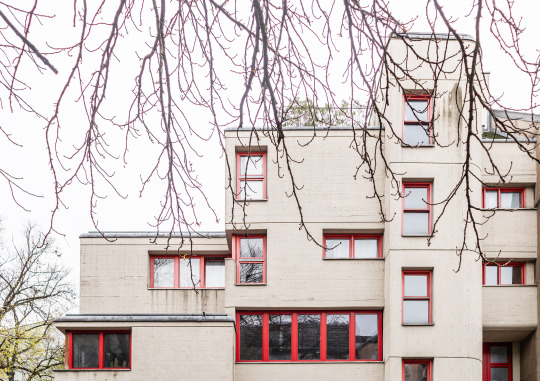

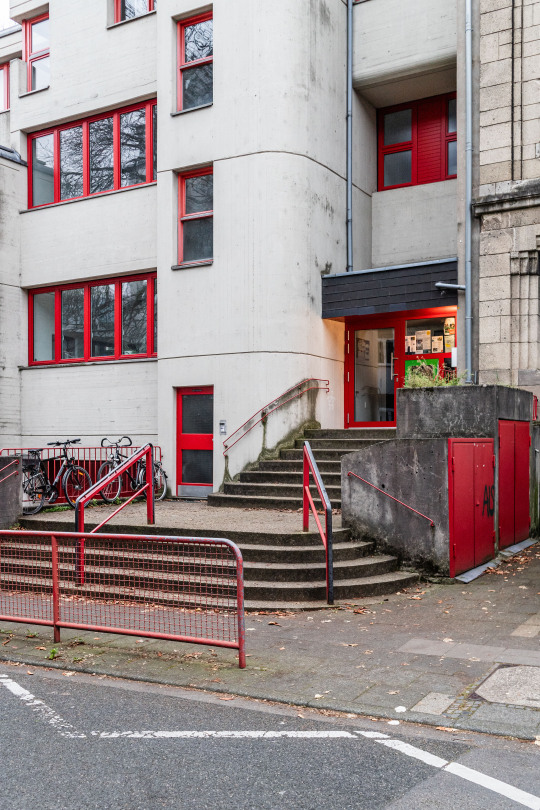
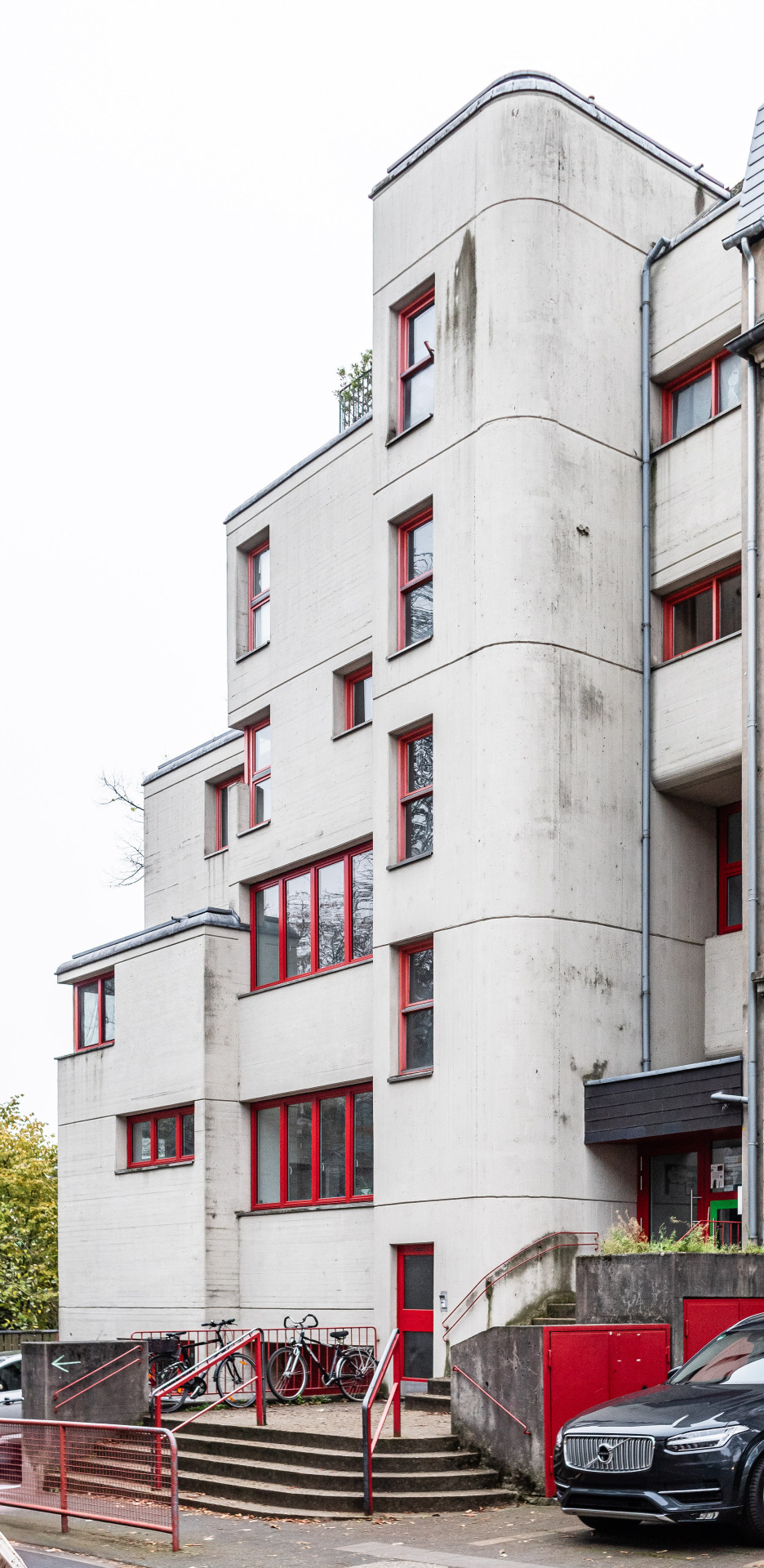
gneisenaustraße // köln nippes
architect: paul georg hopmann
completion: 1974
this brutalist gem, which houses a kindergarten and a community centre, is located in the heart of cologne's nippes district. the striking façade design of pure concrete and red window and door frames, as well as the fragmented structure, make the building a real eye-catcher. the red colouring also extends to the railings, letterboxes and service openings, contributing to the coherent overall impression.
dieses brutalistische kleinod, welches einen kindergarten und ein gemeindezentrum beherbergt, befindet sich mitten in köln nippes. die bemerkenswerte fassadengestaltung von purem beton und roten fenster- und türrahmungen sowie die zergliederte struktur machen das bauwerk zu einem echten hingucker. die rote farbgestaltung erstreckt sich außerdem auf geländer, briefkästen und versorgungsöffnungen, so dass dies zum schlüssigen gesamteindruck beiträgt.
#paul georg hopmann#cologne#moderne#design#köln nipppes#nippes#nbrutalism#brutal archtecture#photography#architecture#germany#architecture photography#urban#nachkriegsmoderne#post war architecture#nachkriegsarchitektur#nachkriegsarchitektur köln#nachkriegsmoderne köln#nachkriegsarchitektur rheinland#nachkriegsarchitektur deutschland#nachkriegsmoderne rheinland#nachkriegsmoderne deutschland#post war modern#german post war modern#german post war architecture#rhineland post war architecture#rhineland post war modern#cologne post war modern#cologne post war architecture
553 notes
·
View notes
Text
Fwd: Postdoc: UCologne_Germany.PlantEvolutionarySystemsBiology
Begin forwarded message: > From: [email protected] > Subject: Postdoc: UCologne_Germany.PlantEvolutionarySystemsBiology > Date: 15 January 2022 at 07:41:49 GMT > To: [email protected] > > > 1 Postdoc position - 36 Months > Evolutionary Systems Biology in Arabidopsis lyrata > Lab. J. de Meaux - Cologne > > Recently, our lab started to explore the genomic and evolutionary > features that associate with the mode of gene expression inheritance. By > bridging approaches in population genetics and transcriptomics with the > traditions of quantitative genetics, we systematically dissect the > component of genetic variation that can directly sustain a response to > selection and try to understand the factors that influence the adaptive > relevance of specific molecular plant traits. The postdoctoral research > associate will expand this line of work and integrate epigenetic, > transcriptomic and phenotypic analyses of variation in the obligate > outcrossing species A. lyrata. In close collaboration with our > international team, the postdoc will also mentor students and actively > participate to the lively scientific culture of our lab. > > This project is funded by the German Ministry of Research and Education > (BMBF) for 36 months. The applicant must hold a PhD in Evolutionary > Biology or Quantitative Genetics (Comparative Genomics, Evolutionary > Genetics, Plant Breeding or Population genetics) and hold advanced > skills in bioinformatic analysis of omics data. Language in the lab is > English. Applications or questions regarding the position should be sent > by mail to [email protected], with the following subject line – > Postdoc application Evol Sys Arabidopsis – de Meaux lab. A letter of > motivation, a CV and the contact of 3 referees should be provided, all > in a single pdf file. Revision of applications will begin in February > 15th 2022 and continue until the position is filled. Funding is for up > to 3 years starting on April 1st 2022 (flexible starting date). For more > information on our lab and research, visit our website > https://ift.tt/2OqstBD. Applicants still in the > process of completing their PhD are encouraged to informally contact the > PI if they have questions concerning the position. The University of > Cologne is an equal opportunity employer in compliance with German laws. > People with disabilities are strongly encouraged to apply. Women are > also strongly encouraged to apply. > Cologne is Germany’s vibrant Metropolis on the Rhine. The city is well > known for its wild carnival, its famous Kölsch beer, its Cathedral and > its vivid contemporary art and musical scene. Cologne is the fourth > biggest city in Germany with over a million inhabitants from all over > the world and an interesting mix of restored historic buildings and > modern post-war architecture. Most importantly, Cologne University is > one of the oldest and largest Universities in the Country. Our research > group is hosted at the Biological Center of the University of Cologne > and associated to the Collaborative Research network SFB680 > (https://ift.tt/3tpc80W) and to the Excellence Research Cluster > CEPLAS (http://ceplas.eu/de/), which fosters active interactions between > plant scientists of the Universities of Cologne, Düsseldorf and the Max > Planck Institute of Plant Breeding Research. In this context, our lab > members are assured to start their scientific career in a world-class > scientific environment. > > > > > Prof. Dr. Juliette de Meaux > University of Cologne > Plant Molecular Ecology > Institute of Botany > Biozentrum > Zülpicher str. 47b > D-50674 Cologne > Germany > > Tel: +49 221 470 8213 > [email protected] > > https://ift.tt/2OqstBD > > > Juliette de Meaux > via IFTTT
0 notes
Text
3. Mainz, Germany
Mainz is an inconspicuous giant in the Germanic world. It is one of the first two capitals in ancient Germany, along with mighty Cologne. In the Middle Ages, Mainz becomes one of the most spiritually-powerful and historically-influential cities of human history. It is the unsung hero of German cities.
While Trier is older than either of them, the Roman cities of Mainz and Cologne become formal capitals of the province of Lesser Germania. The ability of these two cities, to eclipse the obvious cultural power of Trier, and hold on to positions of administrative and political power over the Germanic world, stems from their strategic geographic location. Mainz, specifically, lies at the intersection of the Rivers Main and Rhine, two of the most important rivers in Germany, and the Romans never seem to forget how important this intersection is, as they build, maintain, and even rebuild vital military garrisons, including a river fleet, at Mainz, throughout antiquity. The Romans also place Mainz at the edge of the “Limes,” the wall of fortification that marks the Northern Roman frontier and protects against “barbarians.” This makes Mainz the most vital defensive point in the North, a center of politics, from the beginning.
Because of its position of strength, Mainz remains vital to the Romans until the very end, so much so that the sack of Mainz by Attila the Hun in 451 A.D. sparks the greatest and most final battle of the ancient world, namely, the Battle of Catalaunian Plains. It is the famous face-off between the “Last of the Romans,” Flavius, versus Attila, who is perhaps the greatest threat of all time to Western Civilization. In this epic, and unprecedentedly large, battle, Attila threatens to swallow the Western continent in a Mongolian-style domination, but to his dismay, a polyglot alliance of Germanic, Celtic, Roman, and other soldiers joins together and fights with surprising unity to defeat the polyglot army of Huns and those who follow Attila. The defeat of “Attila the Hun” ends the Eastern threat for over a thousand years in the West, until the formidable march of the Ottoman Turks in the sixteenth and seventeenth centuries, which returns as a second wave of an existential threat from the East.
When the Huns, and the Roman Empire for that matter, leave behind the Germanic region in the fifth century, Mainz falls squarely into the hands of the Germanic people, for all time. “Germany” would not exist today, without Mainz, it is such a strategically-important foundational point for the development of early European Civilization. The stout city of Mainz serves as an Eastern capital for the Franks, the most powerful of all the Germanic Kingdoms. This puts Mainz center-stage in the Frankish Kingdom, alongside Paris and Cologne.
Like Trier, Mainz is an early Christian city in the West. In fact, Mainz is the central hub for the Christianization of the Germanic and Slavic peoples. St. Boniface, known as the “Apostle to the Germans,” is the first archbishop of Mainz, which puts the city literally at the center of the Medieval-Germanic worldview, a time and place when Christianity means everything to the development of the continent. Because of this, the Archbishop of Mainz becomes the most important of the seven Electors of the Holy Roman Empire. This means that Mainz is basically the “unsung capital” of the early Germanic world, the place where the Emperor regularly receives his title, a sacred election ceremony that is, in the Middle Ages, just as important as the naming of a new Pope in Rome.
In fact, the Archbishop of Mainz becomes a substitute for the Pope, North of the Alps, and besides Rome, Mainz is the only “Holy See” in the Catholic Church. This makes Mainz the only city to be an unofficial capital of both the Holy Roman Empire and the Roman Catholic Church, the two most powerful organizations of Medieval Europe. Does that make Mainz the most powerful Medieval city of all of Europe? Little wonder, that by the end of the twelfth century, Mainz is the second-largest Germanic city. It is the spiritual heart of the Germanic people and a conduit through which the Christianization of both East and West takes place.
Finally, and appropriately, perhaps the most influential German of all time comes from Mainz: a High Medieval printmaker named Johannes Gutenberg, the inventor of the printing press. This invention marks a new era in human progress. It is a far-changer in World Civilization. It makes possible the availability of books to laypeople, and for this reason, many historians consider Gutenberg, of the fourteenth century, to be the most important inventor of the last two Millennia, if not all time. His system of movable type expands the human mind and spirit like nothing before it. It makes possible the mass production and consumption of the written word. Human intelligence will always owe much of its advancement to the mechanical system of type of the lowly German printmaker.
The most important single book to print its words on the Gutenberg press is the historically-crushing Luther Bible, a document that single-handedly ends the intellectual and political domination of the Catholic Church over Europe and signals the daw. Of a new era: the transition from the Middle Ages to the Enlightenment, which then leads to the creation and building of the modern world through revolutions in math, science, philosophy, literature, democracy, industrialization, and mass communication. You certainly wouldn’t be reading this blog post, on the Internet, without an invention like the printing press. The Gutenberg Age is essentially the age of global mass communication. When it comes to the flowering of the Golden Age of Western Civilization, one truly considers Medieval Mainz a central point in human history.
It is also important to know that the Germans consider the Gutenberg invention to be of special significance to them, personally, because not only donGermans like to read more than most, but their entire language relies on the Gutenberg Bible for its written format. Before the Gutenberg publication of the Luther Bible, there is no unified German language, and the Culture is so perennially decentralized that no language may ever form, without help. The “help” comes when Luther is able to publish his translation of the New Teatament into the common speech, and this unites the scattered Germanic tongues and forms a single German language, for the first time. Thanks to the Gutenberg press, the German people are now able to come together under a single Culture, which enables them to begin in the sixteenth century to adopt a uniform identity and eventually form organized countries. Without Gutenberg, there is no “Germany.”
In WWII, Allied bombers destroy 80% of Mainz, one of the highest percentages for a large Medieval city, more than Cologne. The bombing destroys a dense Cultural heritage, to say the least. Many of the supposed targets of the bombing remain undamaged by the end of the war. Only the Medieval Old Town, with its cultural sites, is thoroughly ravaged. Thus, it is supposed that the real motive behind the bombing of Mainz is to eviscerate the German soul. The loss of so much cultural wealth from such a city is an irrevocable tragedy and a poignant loss that few in the West have remotely acknowledged.
Overall, the historical importance of Mainz is hardly second to any other city, in the West. It is one of the two original capitals on the Roman map, North of the Alps, but then it remains the most important Christian city of the Germanic world, acting as a second “Rome.” Simultaneously, Mainz is the most stable political center in the unsteady Holy Roman Empire, because it is the permanent home to the most powerful of the seven Electors, in an age where the Emperor seat changes sometimes every few decades. In this environment, Mainz is the “Rock of Ages” to the Germanic world, one of the spiritual-political centers of Medieval Europe. The emergence of the titanic figure of Johannes Gutenberg pushes the city over the edge, when it comes to pure historical centrality. How could a city be more influential than Mainz and yet receive less recognition? Few cities of the world inhabit such a unique position of undeserved obscurity. Although Mainz rarely receives the same level of attention as its twin counterpart Cologne, certainly if spiritual history were the only criteria on which to judge, then Mainz would actually be the best candidate for “most authentic German city.” Even with its destruction in WWII, there persists something distinctly “German” about the architecture of Mainz, that makes it feel representative of some authentic essence of the culture. Certainly, if economic weight is not a factor, then Mainz is the “most authentic German city,” at least prior to its destruction in WWII. It is the soul of its Civilization. Anyone who likes to read books and is not of noble birth probably owes it to Gutenberg. A pilgrimage to Mainz, the city where the democratization of the written word all begins, seems in order.
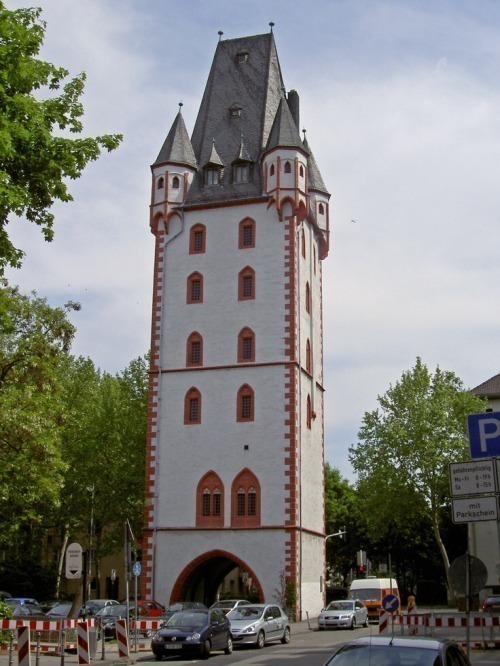
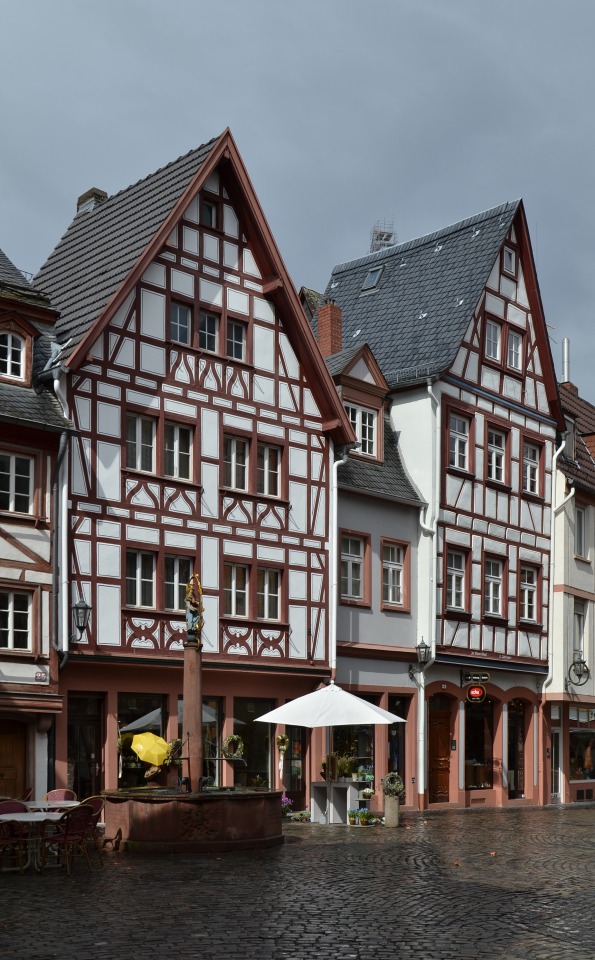
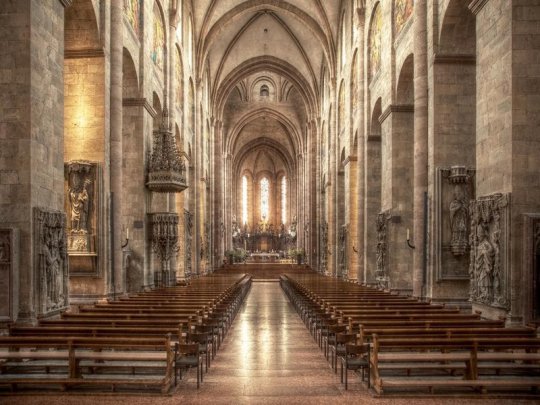







0 notes
Text
Hyperallergic: A Museum Built Among Ancient Ruins Impels an Inward Gaze
Richard Serra, “The Drowned and the Saved” (1992/1997), in the former sacristy of St. Kolumba Church (all photos by the author for Hyperallergic)
COLOGNE — There is a sameness that plagues museums around the world today: A small group of canonized artists are exhibited under standardized rubrics within similarly grandiose architecture, separated into antiquity, renaissance, modern, and contemporary. The opposite is true at Kolumba, the art museum of the Archdiocese of Cologne, where new and old works are exhibited alongside each other to create a deeply introspective, multi-temporal space curated for the purpose of contemplation. In building and maintaining the museum, an inherently religious institution, the archdiocese sought to inspire faith in visitors who are unlikely to visit the church. Awe-inspiring and spiritual to be sure — thought not necessarily godly — Kolumba is a sort of post-religious space for worship.
The space itself is part of the exhibition Me in a no-time state, composed from the archdiocese’s permanent collection, which is reimagined every year with new curatorial proposals. Ruins excavated in Cologne date back to Roman times; it’s upon these that the St. Kolumba Church was constructed during the Middle Ages. It survived until World War II, when it was almost completely destroyed along with the rest of Cologne. Today the ruins are preserved and incorporated into the building by Swiss architect Peter Zumthor.
The ruins of St. Kolumba Church and architecture by Peter Zumthor
“Me in a no-time state” (1994/95) and “Holy Trinity” (17th century)
“We need art so that it can help us look beyond ourselves,” said Joachim Cardinal Meisner, the 94th in the succession of Cologne archbishops, in an interview about the Kolumba for Salve magazine, which was later translated into English and published in a book in collaboration with the museum. Does art inherently fulfill an existential need, or is it the institution that creates the existentialism so present here? Kolumba is a museum centered around emotional questions, not necessarily intellectual or theological hypothesis. The total destruction of war, the ruins of the past and the present are sandwiched vertically within the futuristic, light-filled architecture of Zumthor, which is at once solemn and hopeful.
I visited the Kolumba after a red-eye flight, after having seen literally thousands of artworks in the previous week. I was certainly not expecting to have the wind knocked out of me when I walked into the south tower to see the restored “Holy Spirit Retable” (1448/49) facing Bernhard Johannes Blume’s “71 Designs for Editions in Porcelain” (1985). In this soaring tower, where footsteps and whispers echo off the walls, these two works are alone, along with the weight of the five centuries that separate them.
Workshop of the Wolfgang Retable, “Holy Spirit Retable” (1448/49), tempera painting on conifer wood
The retable is on display after a restoration process that took more than two years. Here the busy Renaissance composition, which contains a whole world, has space to breathe. But the restoration also reveals several psychedelic imperfections: A piece of bread on the table surrounded by Jesus and the apostles seems to bend with the tablecloth, and a water jug has been rendered transparent, as if hanging between this dimension and the next. On the opposite wall, stretching toward the ceiling and large windows above, Blume’s porcelain plates propose thoughts about the retable with nouns, adjectives, and conjunctions in German, like “and,” “is,” “abstract,” “soul,” etc. The south tower is the emotional climax of the current show, and it is representative of the museum as a whole.
Workshop of the Wolfgang Retable, “Holy Spirit Retable,” detail
Johannes Blume, “71 Designs for Editions in Porcelain” (1985)
The real impact of the Kolumba lies in impeccable museology, with an effective mix of spaces in which there is a lot to look at, like rooms 16 and 17, in which Chris Newman’s 2016 installation “Relief Behavior Option” fills the galleries with a crowded group of paintings hanging from the ceiling, and spaces containing only two or three works, such as the south tower and its breathtaking triptych. Newman’s heavy line-work paintings, which look like sketches in a diary, indict his everyday life without any glamorization, recreating the architecture of his small Berlin apartment and immersing the viewer into a loose and sketchy personal narrative. The installation was created specifically for the space at the invitation of the museum, and it is currently on loan from the artist.
Chris Newman, “Relief Behavior Option” (2016)
Newman’s work, and others within the collection, speaks to the humbleness and quiet of the museum itself, which doesn’t seek to attract the attention of the masses — the website is terrible — but to create an inward gaze. The quantity of exhibition space has been carefully thought out: It is neither too much nor too little but entirely manageable, with time and room for each piece to make its mark as the galleries fold into and out of each other. This unpretentiousness is carried through the Kolumba, where the grainy concrete walls are a uniformly soft, warm grey, creating a neutrality that is indifferent to the standard coldness of white museum walls.
Between the south tower and Newman’s installation, a collection of 25 Archivolt figures from the St. Peter Portal at the Cologne Cathedral dating back to the 14th century are scattered around a low gallery and spotlit with warm bulbs. These sacred figures are flanked with contemporary works by Norbert Schwontkowski and Stefan Wewerka. Schwontkowski’s painting, “The Eve Before History Began” (2006), is bathed in natural light from a window looking out over the Cologne Cathedral, and it depicts the Garden of Eden without Adam or Eve, but instead monkeys, suggesting an alternative history of humankind that is at odds with the context of the museum. Wewerka’s sculpture, “CELLA with Kitchen Tree and Swing Chair” (1984), is a futuristic modular living space where every nook, shelf, or seat faces out into the gallery — the opposite of the sheltered and private domestic spaces we are used to.
Various artists, “25 Archivolt figures from the St. Peter Portal at the Cologne Cathedral” (1375–81)
Norbert Schwontkowski, “The Eve Before History Began” (2006)
Stefan Wewerka, “CELLA with Kitchen Tree and Swing Chair” (1984)
In another gallery, fleshy paintings by Eugene Leroy, sensual abstractions of the figure like “Petit nu profond (Small profound nude)” (1997), are again linked to the distant past with a neighboring bust of “Madonna and Child from the Altarpiece of St. Mary in St. Kolumba” (1677), which was rescued from the ruins of the church and restored from 70 fragments after having been destroyed by American and British bombs in 1945. Leroy’s grotesque and textural nudes are also exploded — into tiny fragments of oil paint.
Eugene Leroy, “Petit nu profond (Small profound nude)” (1997)
“Madonna and Child from the Altarpiece of St. Mary in St. Kolumba” (1677) with paintings by Eugéne Leroy
These are only a few examples of how new and old not only exist alongside each other but are merged into one multi-temporal mystery. Curator Stefan Kraus called the space “a continuation of the ruins” from which it was erected, a “vertical museum that penetrates the time axis.” The approach of Kraus and his team includes the ruins within a vision of hope. Whereas fragments of the past are isolated into forgotten history within other museums, here they are part of a dynamic whole: a present time made from many overlapping histories.
The Kolumba is an elegantly sophisticated, unique institution, one where questions about being, time, and art exist together as if they are one and the same. Compared to this space of openness and contemplation, other museums look utterly outdated. The Kolumba emerges from the tradition of the church with a utopian vision of a museum’s purpose.
Stephan Baumkötter, untitled works from the Marfa-Paintings series (1993)
Kolumba reading room
Me in a no-time state continues at the Kolumba Museum (Kolumbastrabe 4) through August 14.
The post A Museum Built Among Ancient Ruins Impels an Inward Gaze appeared first on Hyperallergic.
from Hyperallergic http://ift.tt/2tpWC9f via IFTTT
0 notes
Photo

"Cavaquinho" (c.1914/1915) - Amadeo de Souza-Cardoso (1897-1918) by pedrosimoes7 http://flic.kr/p/U4Wutf Museu Nacional de Arte Contemporânea (Museu do Chiado), MNAC, Lisbon, Portugal Material : Oil on canvas Collection: Private, on deposit at Municipal Museum "Amadeo de Souza-Cardoso (Amarante) ABOUT THE WORK One of the most interesting aspects of Amadeo de Souza-Cardoso explorations in 1914-1915 relates to the subject of "cavaquinhos ", violas and guitars. The bodies of the instruments are demultipled under the influence of cubist deconstruction, but here the static man holding the cavaquinho follows another formal logic: that between a mask and the ethnographic recording peasants in the region on a feast day.The incompleteness and the energy of the background relocate the everyday in the painting space. SOURCE : RHS (MNAC) BIOGRAPHY Amadeo de Souza-Cardoso moved to Paris in 1906. He was 19 and wanted to continue the studies in architecture that he had begun in Lisbon. The vibrancy of the Parisian artistic milieu radically affected his destiny, leading him onto the path of painting. In 1907, taken by the drawings he received from Paris, the writer Manuel Laranjeira (1877-1912) already hailed his young friend as “an artist in the absolute meaning of the word.” Amadeo was born in his parents’ farm in Manhufe, Amarante (Portugal), in 14 November 1887. He grew up among nine siblings, in a wealthy family of rural proprietors. He spent his childhood between the house in Manhufe and the summer resorts at the Espinho beach. There he met Manuel Laranjeira, a friendship that was decisive to fuel the practice of drawing, which Amadeo developed in Lisbon as part of the preparatory studies in Architecutre at the Lisbon Academy of Fine Arts. This was in 1905. The trip to Paris, in November of the following year, in the company of Francisco Smith, had no fixed return date. Financed by his parents, Amadeo settled in at Boulevard Montparnasse and made preparations for the contest to the École des Beaux Arts. However, the Parisian atmosphere reinforced his inclination for drawing and caricature, thus contributing to remove himself apart definitively from the field of Architecture. Particularly influenced by the illustrations circulating in the French press, Amadeo would soon enough devote himself to drawing and painting. The first years of Amadeo’s stay in Paris were marked by the social interactions with other Portuguese émigrés. The studio he rented at 14, Cité Falguiére became a place for gatherings and bohemia, with the frequent presence of artists such as Manuel Bentes, Eduardo Viana (who went with him on a trip to Brittany in 1907), Emmerico Nunes, Domingos Rebelo and Smith. These regular get-togethers did not last long. With the end of 1908, and beginning of the following year, came important changes to Amadeo’s life: he met Lucia Pecetto (1890-1989), who he married in 1914, and he began attending the classes by Spanish painter Anglada-Camarasa (1871-1959) at Academia Viti. He then moved his studio to rue des Fleurus, to a space contiguous to Gertrude Stein’s apartment. These changes might have helped to distance him from the circuit of Portuguese artists. But that voluntary detachment seemed to convey, primarily, a rupture at the visual level and a willingness to break with the “belated routine” he attributed to them. The level of exigency and commitment to the work that he was already producing by then, placed him in a realm that was unparalleled in Portuguese painting, since Amadeo plunged deeply into the investigations of the International Modernism being developed in Paris. It is in that context of formal research that, in 1910, we shall find him excited about the paintings of the Flemish “Primitives” (over a 3-month stay in Brussels). It is also in this period that we find him solidifying his friendship with Amedeo Modigliani (1884-1920). In 1911, Amadeo moved his studio once again. He relocated close to Quai d’Orsay, at rue du Colonel Combes. In October, he took part in an exhibition with Modigliani in this space. This was not, however, the first show of his oeuvre. Some months before, Amadeo had displayed a collection of 6 paintings at the Salon des Indépendents. He would exhibit there again in the following year and in 1914. Likewise, he showed his work at the Salon d’Automne between 1912 and 1914. In the meantime, his circle of friends and acquaintances increased and became more international. He met Umberto Boccioni, Gino Severini, and Walter Pach, who later invited him to participate at the Armory Show. He was also in contact with Juan Gris (1887-1927), Max Jacob (1879-1944), Sonia and Robert Delaunay, Brancusi (1876-1957), Archipenko (1887-1964), Umberto Brunelleschi (1879-1947) and Diego Rivera (1886-1957), among others. Amadeo’s interest in drawing consolidated throughout this period with the preparation of the illustrated manuscript of Flaubert’s Légende de Saint Julien L’Hospitalier* and the publication of the XX Dessins album (reissued by CAM in 1983), with a preface by Jérôme Doucet, which earned a very favourable judgment by the renowned critic Louis Vauxcelles. Amadeo would also endeavour to showcase his painting outside of the Parisian circuit. The contacts he established during these years would allow him to participate in a series of important group exhibitions, among which the famous International Exhibition of Modern Art in 1913, also known as the Armory Show, that displayed European modern art for the first time in the USA (New York, Chicago and Boston). Amadeo submitted a total of eight works, alongside Braque (1882-1963), Matisse, Duchamp (1887-1968), Gleizes (1881-1953), Herbin and Segonzac (1884-1974). Three of his canvases were bought by the Chicago collector Arthur J. Eddy, who, upon publishing Cubist and Post-Impressionism (1914), cited and reproduced some of the works by the Portuguese painter, giving him prominence because of his colouring. Other important contacts would take Amadeo to Germany. In September 1913, after yet another studio relocation (which led him to settle in Montparnasse, at rue Ernest Cresson), he would be represented at the I Herbstsalon in Berlin, organized by the Der Sturm gallery. Amadeo had already worked with this Berlin gallery in November 1912, when he first exhibited in their space. It is highly likely that in 1914 he participated in shows in Cologne and Hamburg, and it is certain that, in April of the same year, he sent three works to the Royal Academy of Arts in London, although this exhibition was to be cancelled as the War broke out. Also in 1914, before leaving Paris to spend the summer in Portugal as usual, Amadeo moved his studio to Vila Louvat, at 38 rue Boulard. However, he would never use this space. After a brief stay in Barcelona where he visited his friend, the sculptor León Solá, and met Gaudí, Amadeo returned to Manhufe where he was surprised by the outbreak of the War, which kept him from going back to Paris. Amadeo’s forced stay in Portugal was not tantamount to a creative apathy. If, whilst in Paris, his work had explored the fields of abstraction, and then followed through paths compromised with Expressionism, the exile in Portugal would end up becoming a moment of full maturity in his painting, approaching many of the questions that were raised by the domain of collage. In 1915, the isolation of Amadeo in Amarante was broken by the contact with Sonia and Robert Delaunay, as they were both also unexpectedly brought to settle in Vila do Conde because of the War. It was through them that his circle of relations recuperated Eduardo Viana, and extended to Almada Negreiros. Within this cluster of friendships, diverse projects would coalesce, namely the creation of a Corporation Nouvelle destined to promote international touring exhibitions, an idea which never came to fruition. Meanwhile, through Almada, Amadeo got in contact with the group of the Lisbon “Futuristas,” initially gathered around the Orpheu magazine. In the struggle to stir things up in the Portuguese artistic milieu, Amadeo played a discreet, yet relevant role. By the late 1916, in a known interview he gave to the O Dia newspaper, he largely paraphrased Marinetti’s manifestos. Not that the propositions of Futurism captivated him as a formal solution. The radical, modernist stance associated with this movement in Portugal, was nevertheless convenient to Amadeo, as a means of intervention and a conduit to break with the dominant traditionalist structures, which had attacked him on occasion of the only two exhibitions he made in Portugal before his death. In December 1916 Amadeo promoted, first in Porto and then in Lisbon, an exhibition for which he had gathered 114 paintings under the title Abstraccionismo. The mismatched aesthetic culture in Portugal foiled a favourable reception of Amadeo’s pictorial propositions, and these shows acquired an aura of scandal (marked, in the extreme, by a physical assault to the painter). It is important to emphasize, in this context, the central role taken by Almada Negreiros and Fernando Pessoa in his public defence. Both recognised him as the most significant painter of their time. But these were, notwithstanding, eccentric and isolated manifestations. In October 1918, Amadeo died in Espinho, the victim of an epidemic of pneumonia which erupted that year. He was only 30 years old. Joana Cunha Leal May 2010 * The manuscript is part of the CAM collection. In 2006, on occasion of the exhibition Amadeo de Souza-Cardoso – Diálogo de Vanguardas, CAM and Assírio & Alvim published it in a facsimile edition, under the title A Lenda de São Julião Hospitaleiro. SOURCE: Calouste Gulbenkian Museum, Modern Collection http://ift.tt/2t23EO6
1 note
·
View note
Text
Gothic Hotels (and Songs by R.E.M., Part 2) — The Agenda by Tablet Hotels
It’s Halloween, so we’re taking a look at hotels with Gothic architecture, a style synonymous with the mysterious and macabre. Why did we also include songs by R.E.M.? The answer may shock you.
Earlier this year, we wrote about some of our favorite Southern hotels, comparing them to songs from one of our favorite Southern bands, R.E.M. So why write about R.E.M. again? Well, the band actually saw the first story, liked it, and asked if we’d do a part two. Not since Coppola and The Godfather has anyone had such a good reason to make a sequel.
There’s hardly been a better time to talk about “scary” hotels, either. This is Halloween week, of course, and it’s also the week that R.E.M. releases the 25th Anniversary reissue of Monster, their terrifyingly titled ninth studio album. But instead of another list of haunted hotels, we’re focusing on the style of architecture most commonly associated with things that go bump in the night.
Gothic architecture secured its association with the spooky and supernatural in the 18th and 19th centuries, when writers like Horace Walpole, Edgar Allen Poe, Mary Shelley, and Bram Stoker chose Gothic castles and abbeys as the backdrop for their stories of darkness and death. An entire genre of horrifying literature became known as Gothic fiction, and an entire mode of architecture was never viewed the same again.
R.E.M. has crossed paths with the Gothic label as well — especially during the first half of their career. With a sound driven up from underneath Georgia’s genteel facade, the Athens natives were considered a sort of modern musical counterpart to the Southern Gothic literature of William Faulkner and Flannery O’Connor. Sonically and thematically, their music reflects the murky and eccentric spirit of the region, underscoring its postbellum tensions and investigating its idiosyncratic characters.
And so, without further ado, enjoy this selection of thirteen hotels with Gothic architectural elements, paired with some of R.E.M.’s most Southern Gothic songs.
Follow along with our R.E.M. — Southern Gothic playlist on Spotify or Apple Music.
The Qvest
Cologne, Germany
“Wendell Gee” — from Fables of the Reconstruction, 1985
The 19th century obsession with Gothic elements comes through loud and clear in The Qvest. Now a hotel, the 1897 building initially housed Cologne’s archives and a public library. In keeping with the reigning aesthetic in those days, a neo-Gothic influence touched just about every element in the construction: ribbed vaults, lancet windows, hood moulding, tracery, and an overarching verticality all remain visible today. Similarly, all the elements of R.E.M.’s Southern Gothic signature come through in “Wendell Gee,” one of the band’s most under-appreciated pieces of musical mastery, and the final track from their darkest and most overtly South-saturated album.
See More Photos
1898 The Post
Ghent, Belgium
“Strange Currencies” — from Monster, 1994
“Strange Currencies” might not feel at first like a song with Southern folk roots, but imagine it without Monster’s trademark distorted guitars and you begin to hear the swagger and sway of classic country-blues. It’s the kind of plaintive-yet-hopeful ballad that R.E.M. perfected throughout their career, and it’s paired on this list with 1898 The Post, a hotel that’s equally the shining example of a genre. The old Central Post Office in Ghent was completed at the turn of the last century, and while its neo-Gothic style makes it look much older than that, a brand-new renovation has this beautifully preserved structure ready to host guests in the current century and beyond.
See More Photos
Bryant Park Hotel
New York City, New York
“Carnival of Sorts (Boxcars)” — from Chronic Town, 1982
Starting with the gargoyle on the cover, R.E.M.’s debut EP Chronic Town oozes a dark, peculiar, and highly literary Southern Gothic vibe. And “Carnival of Sorts (Boxcars),” with its calliope intro and images of clandestine railway activity, all but revels in the murky mood. Gargoyles don’t make an appearance on the Bryant Park Hotel, despite its home inside the American Radiator building, a strange and imposing black-gold gothic skyscraper that towers above the midtown park like something out of a comic book — or out of Ghostbusters. Penthouse guests might be safe from that movie’s statues-turned–terror dogs, but the hotel does look down on the New York Public Library, where other ghost-busting scenes were filmed.
See More Photos
Kruisherenhotel Maastricht
Maastricht, Netherlands
“The One I Love” — from Document, 1987
“This one goes out to the one I love…” — the instantly recognizable first line from R.E.M.’s 1987 hit sets the stage for a song that practically drips with heat and humidity. This song, as much as any other, announced to the world that R.E.M. was a contemporary sonic interpretation of the steamy South found in the plays of Tennessee Williams. Kruisherenhotel Maastricht is another thoroughly modern interpretation, this time of a fifteenth-century Gothic monastery. Designer Henk Vos transformed the original monks’ cloisters into handsome hotel rooms that are anything but ascetic, and even the relatively undisturbed spaces are deeply altered by the introduction of sleek furnishings and bits and bobs by the likes of Le Corbusier, Philippe Starck and Marc Newson.
See More Photos
Conservatorium Hotel
Amsterdam, Netherlands
“Country Feedback” — from Out of Time, 1991
The Conservatorium is a radical repurposing of Amsterdam’s Sweelinck Conservatorium building — its soaring institutional spaces and ornate century-old neo-Gothic construction transformed into a contemporary design hotel. Offering a focus on pop music alongside more traditional conservatory studies like classical and jazz, there probably was a surprising bit of guitar feedback heard in the Conservatorium during its time as a music school. There’s a bit of feedback heard in “Country Feedback” as well, wandering almost incongruently in between and around more traditional country sounds like pedal steel guitar and organ, adding the right amount of frustration and edge that the song’s cryptic lyrics cry out for.
See More Photos
Ace Hotel Downtown L.A.
Los Angeles, California
“So. Central Rain” — from Reckoning, 1984
Legend has it that “South Central Rain” refers to massive downpours and flooding in R.E.M.’s home state of Georgia in 1983. The band was apparently out on tour, and wasn’t able to check in on family members because the storms had knocked out the phone lines. Specifically, the legend asserts, they were in Los Angeles, which is the reason for this hotel-song pairing, and not because of L.A.’s South Central neighborhood. For the Gothic connection, look no further than the United Artists building, a 1920s Spanish Gothic Revival tower and theater that is the current home of Ace Hotel Downtown L.A.
See More Photos
SINA Centurion Palace
Venice, Italy
“Oh My Heart” — from Collapse Into Now, 2011
Michael Stipe wrote “Oh My Heart” about post-Katrina New Orleans. His lyrics can sometimes be impenetrable, but not here. This is very clearly a song about resilience in the face of tragedy and persevering into the future so we can continue to honor the past. There are no New Orleans hotels on this list, but maybe that would’ve been too cute. Instead, we turn to another timeworn city fighting back against Mother Nature and climate change: rising sea levels have led to regular flooding in Venice, the home of Centurion Palace and its postcard-perfect Venetian-Gothic exterior. The former convent is located in one of the oldest neighborhoods in the city, which has survived everything from World Wars to the Black Death, and we’re confident it will survive its latest challenge.
See More Photos
Chicago Athletic Association
Chicago, Illinois
“Oddfellows Local 151” — from Document, 1987
Long before a recent renovation converted it into a stunning boutique hotel, the Chicago Athletic Association was a private club for the city’s (male) movers and shakers. Dating back to the final decade of the 19th century, this Venetian Gothic landmark hosted the kinds of government and business elite that “Oddfellows Local 151” suggests are at least partially responsible for the plight of the characters in the song: the homeless population that was left behind by the political and economic machines of 1980s America. Document was an album filled with fiery passion as R.E.M. found their political footing — no more so than on this, its closing track.
See More Photos
High Line Hotel
New York City, New York
“Swan Swan H” — from Life’s Rich Pageant, 1986
Chelsea’s High Line Hotel makes its home in an imposing red-brick Collegiate Gothic seminary — and its designers, the local duo Roman and Williams, managed to created an enormously fun hotel in what was an otherwise solemn environment. R.E.M. pulled the same trick, but in the opposite direction, with “Swan Swan H.” At first glance, this song about the Civil War appears to be a celebration of freedom, but as it progresses the true cost of a destructive moment in American history becomes more clear. And while the lyrics reference wooden beams of a presumably different sort, for the purposes of this list, we’ll think about the ornate ceiling of the Hoffman Hall event space, pictured above.
See More Photos
Le Chateau Frontenac
Quebec City, Canada
“World Leader Pretend” — from Green, 1988
A century-old Gothic Revival castle high on a bluff over the St. Lawrence river, Le Château Frontenac is Québec City’s most famous landmark, and has hosted some of the world’s most famous guests. Musicians, movie stars, and titans of industry have walked its halls, but powerful politicians may have left the greatest influence — suites are themed after heads of state who have stayed at the hotel. According to Michael Stipe, “World Leader Pretend” was the most political song of the band’s career up to that point, and it might continue to be so today. After clashing with Donald Trump over his unauthorized (obviously) use of “It’s the End of the World as We Know It (And I Feel Fine),” the band followed up by contributing “World Leader Pretend” to an anti-Trump compilation.
See More Photos
Chateau Marmont
Los Angeles, California
“Drive” — from Automatic for the People, 1992
The Chateau Marmont was constructed to the specifications of the Loire Chateau Amboise in France, and scattered throughout are certain reminders of the French late Gothic Flamboyant style. But though inspired by France, this particular chateau and its infamous scenes of Hollywood decadence could only exist in Los Angeles. Likewise, “Drive” is a song that could only have come from R.E.M. With an echoey atmosphere as haunted as the hallways of the Chateau, the song drives forward slowly and madly, calling out like a pirate radio station in the middle of the night, seeking to empower the youth through rock and roll.
See More Photos
St. Pancras Renaissance Hotel
London, England
“Life and How to Live It” — from Fables of the Reconstruction, 1985
In R.E.M.’s hometown of Athens, Georgia, there once lived a man named Brev Mekis. Suffering from schizophrenia, Brev split his house into two totally different apartments, each with its own unique furniture, books, clothing, even pets. To suit his disparate personalities, Brev would periodically switch back and forth between his two lives. After he passed away, discovered inside the house were hundreds of identical copies of a book he had written called: “Life and How to Live It.” The great Gothic structure at St. Pancras has a split personality of its own. On the one hand, it is a lavish, luxurious hotel. On the other, an introduction to a busy, full-functioning rail station. Taken all together, it is the ideal of a grand European railway hotel.
See More Photos
Borgo dei Conti Resort
Perugia, Italy
“Find the River” — from Automatic for the People, 1992
Borgo dei Conti Resort is a deeply romantic place. Originally built as a fortress in the 13th century, the estate was remade into a noble home some 500 years later. Surrounded by acres of gardens and lawns and parkland, the building is a dramatic example of 19th-century neo-Gothic architecture, still as imposing as ever today. On its sprawling grounds, you’re likely to find some of the herbs and fruits mentioned in “Find the River,” a song that celebrates life specifically because death is always present. Despite the heavy themes, “Find the River” is a gorgeous and uplifting song. It closes out an album full of radio hits, and is equal to or even better than each of those more well-known singles. All of this is coming your way.
See More Photos
from Cheapr Travels https://ift.tt/2qdR9l4 via IFTTT
0 notes
Link
Artist: Yutaka Matsuzawa
Venue: Yale Union, Portland
Curated By: Alan Longino, Reiko Tomii
Date: June 30 – August 18, 2019
Note: A text associated with the exhibition written by Alan Longino can be downloaded here.
Click here to view slideshow
Full gallery of images, press release, and link available after the jump.
Images:
Images courtesy of Yale Union, Portland
Press Release:
Yutaka Matsuzawa (1922–2006) was considered the father of Japanese conceptual art. Born in Shimo Suwa in central Japan, he studied architecture during the war, and upon witnessing the after effects of the firebombing of Tokyo in March 1945, he proclaimed upon his graduation from school that he wished “to create an architecture of invisibility.” Once he gave up architecture, he wrote poetry, made paintings, and worked as both an artist and teacher in his hometown. In his pursuit of ways to express the invisible invisibly, Matsuzawa began to develop a unique understanding of conceptual art that both elevated and transcended the typical notions of conceptual art in the western, euro-centric art worlds. However, exhibitions and publications for Matsuzawa in the West have only occurred infrequently, and to this day his work has still not been given the same space for consideration and understanding that many others situated in the West have thus received.
In light of this history, the exhibition at Yale Union will be the first in the U.S. for the artist, and alongside the exhibition the artist’s seminal publication, QUANTUM ART MANIFESTO, from 1988, will be re-published for the first time outside of Japan in an edition of 500. During the exhibition, art historian Namiko Kunimoto will speak on the collaborative work between Yutaka Matsuzawa and the female Butoh dancer, Tsujimura Kazuko.
Alan Longino is an art historian and curator based in Cologne, Germany. His M.A. thesis in Art History from CUNY Hunter College (2017) focused on the event of telepathy within information as the source of image production. His writing has appeared in the Haunt Journal of Art, from UC Irvine.
Reiko Tomii is a New York-based scholar and curator who investigates post-1945 Japanese art as a vital element of world art history of modernisms. She organized exhibitions with Yutaka Matsuzawa until his death in 2006. Her book Radicalism in the Wilderness: International Contemporaneity and 1960s Art in Japan was published by MIT Press and won the 2017 Robert Motherwell Book Award, which recognizes outstanding publications in the history and criticism of modernism in the arts. The book has recently been turned into an exhibition Radicalism in the Wilderness: Japanese Artists in the Global 1960s, currently on view at Japan Society Gallery in New York (through June 9), in which Matsuzawa is prominently featured.
Link: Yutaka Matsuzawa at Yale Union
Contemporary Art Daily is produced by Contemporary Art Group, a not-for-profit organization. We rely on our audience to help fund the publication of exhibitions that show up in this RSS feed. Please consider supporting us by making a donation today.
from Contemporary Art Daily http://bit.ly/33nYltZ
0 notes